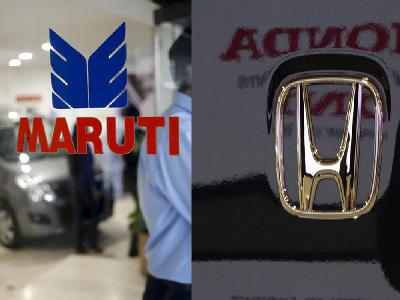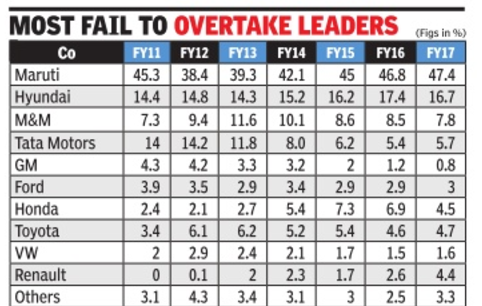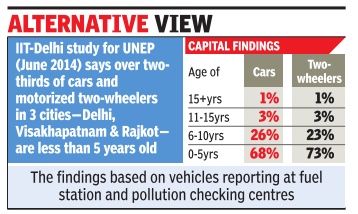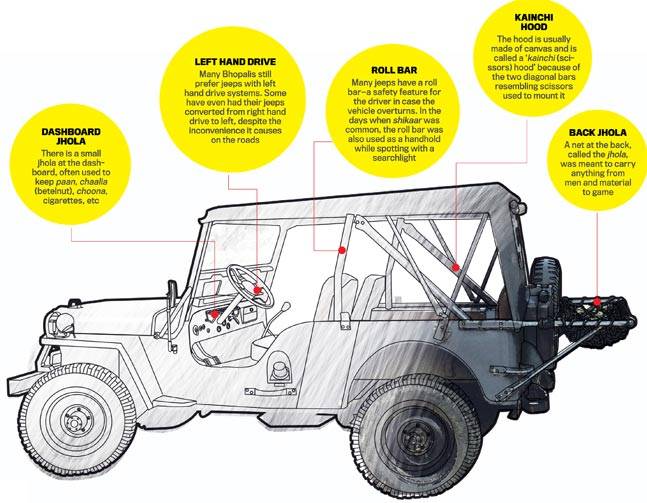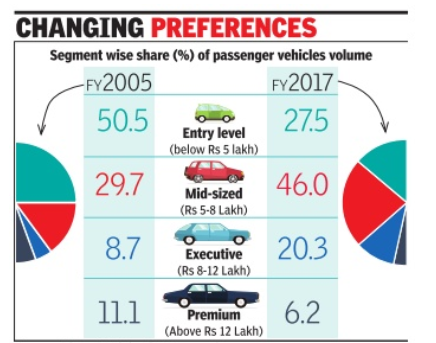Automobile industry: India
This is a collection of articles archived for the excellence of their content. |
After-sales service ranks
2014-2015, company-wise
- Honda and Maruti Suzuki rank highest after-sales customer service
- Maruti Suzuki holds this position for the 17th consecutive year
- Hyundai and Tata rank third in a tie at 888
CHENNAI: Even as automotive manufacturers collectively improve their after-sales service satisfaction for the eighth consecutive year in India, satisfaction levels and service consistency vary greatly across the regions of the country, according to the JD Power 2016 India Customer Service Index (CSI) Study for the mass market segment released on Friday.
Honda and Maruti Suzuki rank highest in satisfaction, in a tie, with after-sales customer service among mass market brands, each with a score of 901. Maruti Suzuki holds this position for the 17th consecutive year, while Honda ranks highest for the first time. Maruti Suzuki performs well across all factors and Honda shows strong improvement across all factors, with the greatest improvements in service initiation and service quality. Hyundai and Tata rank third in a tie at 888, and are the most improved nameplates in the study.
Overall service satisfaction in the mass market segment in India improved by 14 points to 880 on a 1,000-point scale in 2016 from 866 in 2015. Overall satisfaction in the West region is 900, while overall satisfaction in the North region is 857.
Strong differences in customer behavior, preferences and expectations of their after-sales experiences contribute to the substantial disparity in the regional scores. For example, 82% of vehicle owners in the West region schedule an appointment for their service visit, while only 55% of customers in the North region schedule their appointment, affecting dealers' ability to effectively manage unscheduled workload and maximize throughput. Additionally, owners in the North region drive their vehicles an average of 11% more than those in the other three regions in the first 12-24 months of ownership, indicating that dealers in the North region have to account for more wear and tear issues when customers bring their cars in for service.
"In an astoundingly diverse market like India where every region and state has its own unique characteristics and needs, dealers need to capitalize on every customer interaction opportunity to develop points of differentiation and deliver on those expectations," said Mohit Arora, executive director at J.D. Power. "By being attuned to the differing customer needs across the country, dealerships can continuously adapt their service processes to consistently deliver a superior customer experience."
The study finds that dealers are improving in their communication activities with their customers at every service juncture, and that is having a positive impact on overall satisfaction. Nearly nine in 10 (89%) customers say they were reminded by the dealership about their vehicle service, an increase from 86% in 2015. Additionally, 93% of customers say their service advisor ensured that they fully understood the scope of work being performed on their vehicle, up from 90% in 2015. Following their service, 89% of customers say they were informed about when to schedule the next visit, up from 83% in 2015. Overall satisfaction among customers who receive all three of these communications is 899, compared with 818 among those who do not receive such communications from their dealers.
"Dealers are at the frontline of interacting with customers and hence represent the automotive brand that they carry," said Kaustav Roy, director at J.D. Power. "It's critical that every communication milestone is handled properly. Any gap in communication may have the unintended effect of lowering satisfaction, as well as customer loyalty, and the negative impact may be magnified when it gets passed on through word of mouth."
Among customers who are highly satisfied with their dealer service (overall satisfaction scores of 980 and above), 92% say they "definitely would" revisit their service dealer for post-warranty service, compared with only 44% of dissatisfied customers (818 or lower). Furthermore, 93% of highly satisfied service customers say they "definitely would" recommend their service dealer to family and friends. In contrast, only 50% of dissatisfied customers intend to recommend their dealer.
Now in its 20th year, the study measures new-vehicle owner satisfaction with the after-sales service process by examining dealership performance in five factors (listed in order of importance): service quality; vehicle pick-up; service advisor; service facility; and service initiation. The study examines service satisfaction in the mass market segment. Satisfaction is calculated on a 1,000-point scale.
The 2016 India Customer Service Index (CSI) Study is based on responses from 7,843 new-vehicle owners who purchased their vehicle between May 2014 and August 2015. The study was fielded from May through August 2016
Automobile manufacturing hubs in India, state-wise
2016
The Times of India, September 11, 2016
Swaminathan S AnklesAria Aiyar
Tata shifted its Nano plant from Singur to Sanand, Gujarat. Can acquisition of land at Sanand be struck down as not serving a public purpose? Many states competed to attract the plant. Gujarat won by offering cheap land, tax breaks and concessional finance. Can all these be struck down too? Gujarat has long been highly industrialised but dominated by oil and chemical industries creating few jobs. Narendra Modi as chief minister visualized the Sanand plant as not just a Tata factory but an incubator of auto ancillaries and skills that would make Gujarat a major auto hub with lakhs of jobs, like Delhi, Maharashtra and Tamil Nadu.
Events have vindicated him. The Nano itself was a giant flop, and Tata will have to shift to other models.But the project created many auto ancillaries and skills that have indeed attracted several other auto majors, and converted Gujarat into an auto hub. Tata may have failed but Gujarat has succeeded.
Ford built its first plant in Tamil Nadu but moved to Gujarat in 2015 for its second plant. Honda and MarutiSuzuki, both of which began with car factories near Delhi, are now building new plants in Gujarat.Maruti-Suzuki will be by far the biggest investor, with an initial capacity of 250,000 carsyear rising to 1.5 millionyear with an outlay of a whopping Rs 18,500 crore. AMW Motors has built a heavy truck plant with a capacity of 50,000 heavy trucks per year. Atul Auto, a producer of commercial three wheelers, is planning a second plant near Sanand.
Honda Motorcycle and Scooters India has set up a plant producing 1.2 million Activa scooters per year.Hero MotoCorp is constructing a plant with an initial capacity of 1.2 million two-wheelers, to be raised to 1.8 million. Gujarat will span the full range from two-wheelers to cars to trucks.
The Nano factory initially spawned 41 auto ancillary plants. The number is projected to rise to 350, mostly in the Sanand-Mandal-Becharaji region. The big names include Canada's Magna International, Germany's Bosch and Switzerland's Oerlikon. Old-time tyre-makers Apollo and Ceat have been joined by newcomers like Taiwan's Maxxis Tire, Yokohama Tyres and MRF.
These successes more than compensates for the failure and likely closure of the state's first auto plant of General Motors at Halol. This was in any case too small to spark an auto hub. Sanand has the requisite scale.
In sum, forced acquisition is usually wrong, and Gujarat has rightly shifted mainly to negotiated land purchases. But there can be exceptions that justify acquisition, and the auto hub in Gujarat is one such example.
Automobile sales
2004-13: Sales of cars in India
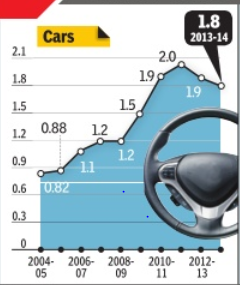
See graphic:
Sales of cars in India, 2004-13
2014-19
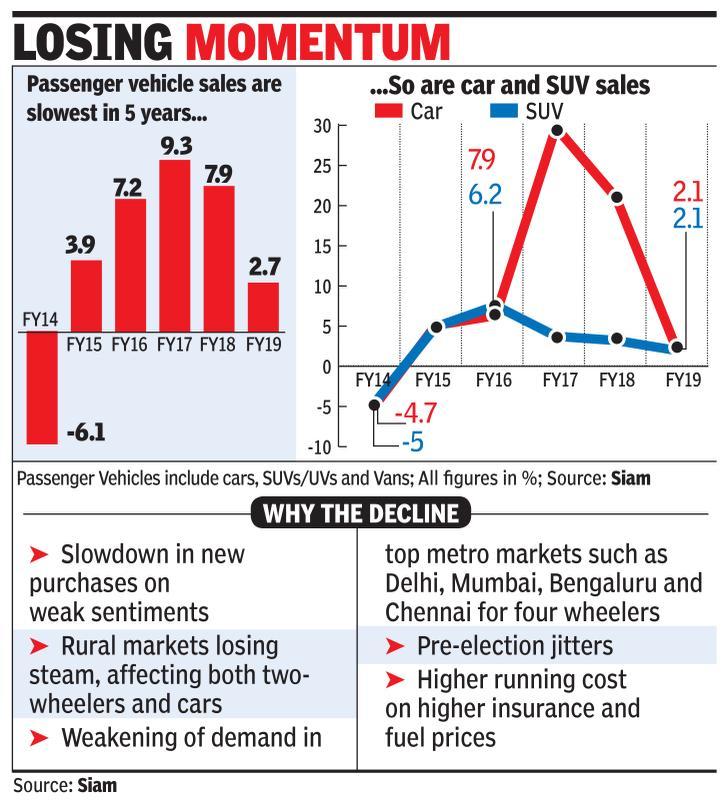
Both 2014 and 2019 were election years.
From: Pankaj Doval, April 9, 2019: The Times of India
See graphic:
Passenger vehicle sales in India, 2014-19;
Both 2014 and 2019 were election years.
2009-15: 5% growth
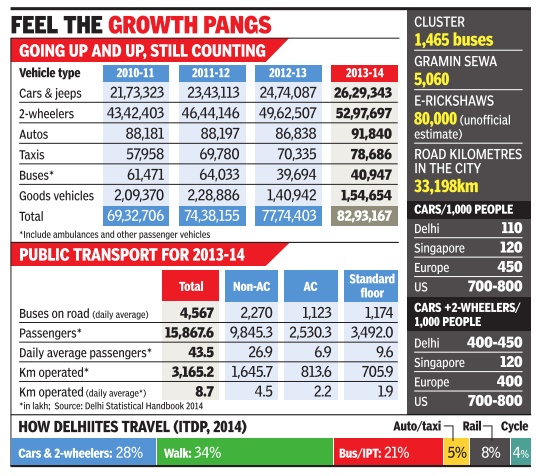
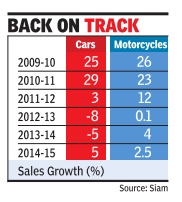
Apr 11 2015
Pankaj Doval
Car sales up after 2 yrs of decline
After two successive years of decline, car sales registered a 5% growth in the financial year (2014-15). But the revival may not be sustained in the current financial year due to an adverse impact on the rural economy after unseasonal rains.
Car sales fell 5% in 2013-14 and 8% in 2012-13 as high interest rates and growing fuel prices had dampened buyer sentiment.
The car industry has started showing some positive traction after entry of the Narendra Modi government in May last year. Modi's entry , which revived hopes of an economic turnaround, also coincided with a cut in fuel prices and a marginal reduction in interest rates. These positive factors, coupled with a low base year, led to a growth in sales numbers.
But a weak rural economy may play spoilsport. The difficult journey of the rural economy started last year with a deficient monsoon. This year also, unseasonal rains have damaged rabi crops.
The impact of an affected rural economy is already visible on the sales of motorcy cles, which grew only 2.5% in 2014-15, lagging a 25% growth witnessed by scooters. Sales of bikes fell 6% during the last quarter of 2014-15. Analysts said with rural economy playing an increasingly bigger role in the sales of small cars and motorcycles, an adverse demand impact here could hit the overall sales momentum.
“We are already feeling the pressure of a slowdown in the rural economy ,“ Vishnu Mathur, DG of industry body Society of Indian Automobile Manufacturers (Siam), told TOI.“Sales in the rural regions are critical for growth in some of the important categories, especially motorcycles.“
According to some estimates, rural economy accounts for around 30% to total sales of car makers -especially in case of mass-market manufactur ers like Maruti and Hyundai, while in motorcycles, the share has reached nearly half.
“Market sentiment in some rural areas has been impacted due to various factors, including the curtailment of national rural employment guarantee act (NREGA) spends, poor crop realisation and moderating wages,“ an official at top twowheeler maker Hero MotoCorp said. “The industry has, therefore, felt some impact in retail off-take in markets such as Bihar and Madhya Pradesh and sugar cane-growing areas in Uttar Pradesh and Maharashtra.“
The scooter category , however, is somewhat insulated from the agri pressure as it has abig share of the urban market.
The weak trends in rural India are worrisome for car manufacturers, which had turned their focus on agri-led regions.
2009-18: SUV sales grow 7x faster than cars
Pankaj Doval, SUV sales grow 7x faster than cars, April 14, 2018: The Times of India
See graphic:
i) Passenger vehicle sales, 2009-18: Share of SUV sales;
ii) Growth of sales of SUVs and cars, 2017-18.
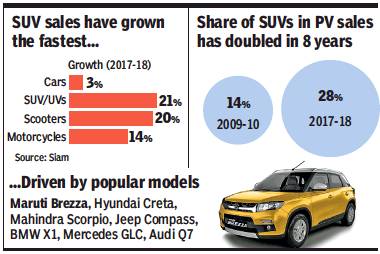
ii) Growth of sales of SUVs and cars, 2017-18.
From: Pankaj Doval, SUV sales grow 7x faster than cars, April 14, 2018: The Times of India
If you thought that small cars and sedans are where the heart of the Indian buyer is, think again. Sale of SUVs grew seven times faster than that of passenger cars in 2017-18, the trend being fuelled by new models and changing lifestyles. While small cars and sedans managed a growth of 3% in the last financial year, the sales of off-roaders grew 21%, the fastest in the personal commuter segment, which also includes scooters (20% growth) and motorcycles (14%). And, the share of SUVs in overall passenger vehicle sales rose to nearly 30% in 2017-18, compared to 14% recorded at the end of March 2010.
According to numbers released by the Society of Indian Automobile Manufacturers (Siam), 9.2 lakh SUVs were sold in 2017-18 against 7.6 lakh units in the previous year. The non-SUV segment (compact cars and sedans), while accounting for larger volumes, has been nearstagnant in terms of growth — sales stood at 21.7 lakh units in 2017-18 against 21 lakh units in 2016-17.
Market analysts said the trend is only going to get stronger as SUVs will continue to remain favourite with Indian buyers and companies will drive in new models. “SUVs are the order of the day, in line with global trends, and will continue to remain strong,” Rakesh Srivastava, director (sales & marketing) at Hyundai India, told.
For Hyundai, share of SUVs in total sales has grown to a little over 20% now, against less than 10% before 2015. The company’s entry SUV Creta (price starts from under Rs 10 lakh), has driven this change. “SUVs are naturally suited for the Indian geography with a large road network. Their strong body architecture, higher seating position and relatively-larger cabin space make them highly desirable with buyers,” Srivastava added.
Affordability has helped SUV sales too
Affordability has also led to the rise in sales of SUVs. Models such as Maruti’s Brezza and Ford’s Eco Sport are priced under Rs 10 lakh, enabling many people to fulfil their desire to own an off-roader.
“SUVs have always been highly aspirational. Earlier they were very expensive. With the entry of affordable options, people have really fallen for them. For many, SUV is a lifestyle statement and an extension of their personality,” said a senior industry official, requesting anonymity.
But while affordability is driving in volumes, the trend is equally strong in premium and luxury categories. Jeep Compass (starting from Rs 15 lakh), the first locally-built SUV from Fiat Chrysler India, has seen a strong response.
“The Compass took consumer aspiration to the next level. We have already sold over 20,000 units in just eight
months, and are working on new orders,” a senior official at Jeep’s parent Fiat Chrysler said. “This kind of demand demonstrates Indian market’s appetite for SUVs.”
The company is now working on another SUV Renegade, to be priced lower than Compass.
Mercedes-Benz, that leads the luxury market in India, gets nearly 35% of its sales from SUVs, including models such as GLC and GLE. “Indian customers have a penchant for SUVs and they are preferred for better road presence, proven off-road capabilities, practicality, and also for travelling with families,” Roland Folger, MD & CEO of Mercedes-Benz India, said.
Folger said even women buyers are taking a higher interest in owning and driving SUVs. “They find SUVs to be practical, comfortable, and safer.” Industry officials estimate that the share of SUVs in overall passenger vehicle sales may further move up beyond 30%, on the back of strong demand and new models.
Nandini Sengupta|Top car cos maintain mkt share growth|Jul 15 2017: The Times of India (Delhi)
Big gets bigger, small becomes smaller: The Indian passenger vehicle market has become a losing market share game for the vast majority of players apart from the top 3 and the rare exception of Renault.According to SIAM data, market leader Maruti has seen a steady upswing in market share since FY12. Arch rival Hyundai too has remained on the upward curve, though it did slip a little in FY17. M&M has been up since FY11, but has gone flat negative in the last three fiscals. As for the rest, even big MNC names like Toyota and Ford have remained flat market share-wise, even as Honda and Volkswagen have slipped.Tata Motors has been one of the biggest losers, seeing its market share come down to less than half (see table). Maruti's market share climb -up to 50.4% by June 2017 -is on the back of its product pipeline. Between February 2014 and March 2017, it has rolled out seven new products -Celerio, Ciaz, S-Cross, Baleno, Vitara Brezza, Ignis and Baleno RS. In FY 17-18, too, it plans to bring two new models and two upgrades. Unsurprisingly , Maruti has outpaced the industry in growth for five years.
Said K Ayukawa, MD & CEO, Maruti Suzuki, “There are over 18 players in the market. Our target is to focus on our business and achieve our target of 2 million unit sales in 2020. Our endeavour will be to study our customers' demands and offer them a range of products. If we listen to them carefully, market share will follow.“
Top officials say that's because Hyundai has not had any mass-market launches in FY17.Its only launch Tucson is a high-end niche SUV . Said Rakesh Srivastava, senior VP (sales & marketing), Hyundai Motor India, “Building processes and services to consistently gain customer confidence, building an aspirational premium brand, product launches in the volume segment with high price-value proposition and strong, extensive channel partners -this is the recipe to gain market share in India.“ Brands that are floundering are doing so because they don't tick one or more of these four boxes.
Indeed, Renault's jump from 1.7% in FY15 to 4.4% in FY17 has been driven by the success of the Kwid.
2012-17: Car and SUV sales
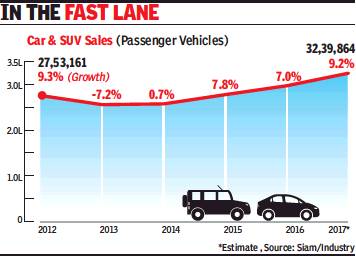
From: Pankaj Doval, Car sales grow highest in 4 years to cross 3m in 2017, January 2, 2018: The Times of India
As We Enter 2018, Industry Shrugs Off DeMon, GST Impact
A ‘double Diwali’ in 2017 — on the back of advancement of purchases due to the GST rollout — ensured that car and SUV sales rose the fastest since 2013 and crossed the 3-million mark for the first time ever. Even the demonetisation blues could not curb spirits as new models — especially SUVs — and attractive discounts aided the near 10% surge in volumes.
According to initial industry estimates, passenger vehicle sales in 2017 grew by 9.2% to nearly 3.2 million against 2.9 million units in 2016. “These are initial estimates, and the final numbers could be even higher,” an industry source said.
The growth comes despite doubts at the beginning of the year over where the industry had been heading. The start of the year was nearly at the peak of demonetisation (announced on November 8, 2016) and buyers — short of cash — were keeping off showrooms and new purchases.
“The industry has done well, and we are looking forward to the new year now,” Maruti chairman RC Bhargava told TOI. The company sold a record 1.6 million cars in 2017 at a growth of 15%, and this meant selling one in every two cars.
After the initial fears around demonetisation, things started turning around as pent-up demand was unleashed on fears of a duty hike in the GST regime that was rolled out from July. Rakesh Srivastava, director (sales & marketing) at Hyundai India, said, “The GST implementation had led to uncertainty and fear in the minds of people who thought that prices will go up. This led to strong growth in April-June period.”
Another factor that aided the demand was good monsoon that saw good uptake in rural and semi-urban areas. Sugato Sen, deputy DG at industry body Society of Indian Automobile Manufacturers (Siam), said, “On an average, rains were much better than the last two-three years. This helped in realising higher rural demand.”
Company executives said that the festive season also remained “fruitful”, which helped in the continuation of the momentum. “Even as we have crossed an all-time high, we expect 2018 also to be good. The economy should do well, and help the market respond positively,” Sen said.
SUVs have been a big driver in boosting the demand for passenger vehicles, and much has been riding on models such as Maruti’s Brezza, Hyundai’s Creta and the newly-launched Jeep’s Compass.
The Times of India, Sep 10 2016
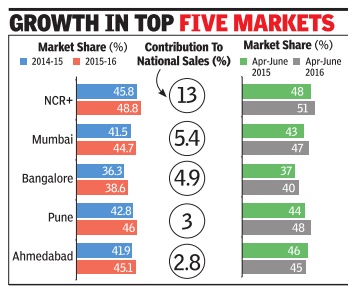
Nandini Sengupta
A new focus on utility vehicles, a premium channel in Nexa and marketing aggression has helped Maruti Suzuki increase its marketshare in all the top 11 cities that form the creamy layer of the passenger vehicle market in India. The company has gained between 1-3% across the top car cities in India --DelhiNCR region, Mumbai, Bengaluru, Chennai, Pune, Ahmedabad, Hyderabad, Kolkata, Kochi, Jaipur and Lucknow.Collectively these top 11 cities comprise 40% of Maruti's total domestic sales.
“Enhancing market share in the top cities has been one of Maruti Suzuki's major achievements in the recent past. Our network is these markets is much stronger. Nexa has redefined the purchase and ownership experience. But it is our products that have played a key role: the design, features, safety and technologies like mild hybrid and AMT have made our vehicles much more appealing for urban customers,“ said R S Kalsi, executive director, marketing & sales, Maruti Suzuki.
The highest gain has been in the Delhi-NCR region whe re the company's marketshare has risen from 45.8% in FY15 to 48.8% in FY16 and 51% in Q1 of FY17 (see table). In Mumbai, Maruti's marketshare has increased from 41.5% in FY15 to 44.7% in FY16 and 47% in Q1 of this fisccal.Marketshare in Bengaluru is up from 36.3% fiscal before last to 38.6% last financial year to 40% this Q1. Collectively, these three cities comprise over 23% of Maruti's national sales. There are 17 auto companies jostling for a footprint in the passenger vehicle market.
The urban focus has helped Maruti gain marketshare at a time when poor rainfall caused rural markets to shrink. The Nexa network not only strengthened the urban focus but also helped aggressively sell vehicles to suit the changing taste of these markets.
2012-15: Three manufacturers dominate
The Times of India, January 28, 2016
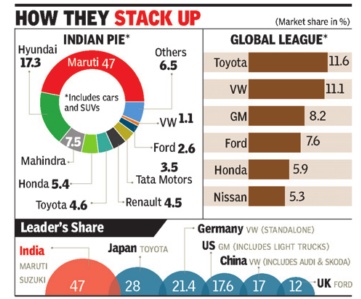
Nandini Sengupta
Top 3 auto cos hold 70% mkt share'
India is the only country in the world where the top three auto manufacturers increased their market share to 70% for April-December 2015 compared to 67% in 2012, as per industry data. The pecking order has largely remained unchanged in the last five years. Also, the share of the top 10 models in the total sales has remained more than 50% for the last three years. The only change in the pecking order has been Mahindra & Mahindra moving into the third slot in 2013-14, ousting Tata Motors. Auto marketers say this overwhelming dominance of a few players in a market, which has 18 car and SUV manufacturers, is something peculiar to India alone. R S Kalsi, ED (marketing & sales), Maruti Suzuki India, said, “There is no other example of this trend anywhere else and the highest marketshare by a single company , apart from Maruti in India, is Toyota in Japan with around 30%.“
The top two's dominance of the market becomes obvious when one considers that their incremental volumes are more than what some of their competitors sell in a year. Rakesh Srivastava, senior VP (sales and marketing), Hyundai Motor India, said, “Last year, our sales went up 16% to 4.76 lakh units in the domestic market and this incremental increase is higher than the annual sales volume of 10 auto companies in India.“
Experts say part of this is due to the early mover advantage and the ability to focus on a solid distribution channel. Maruti Suzuki, for instance, has 1,750 showrooms and 3,000 workshops, while No. 2 player Hyundai has 1,070 showrooms, 370 used car outlets and 335 rural sales outlets.
But part of it also has to do with the existing car pool and the Indian customer's comfort level with a productbrand that has strong resale value. Indeed the three years of slowdown has reinforced the customer's tendency to go with what's tried and tested. “Typically Indian customers are willing to experiment during an economic growth phase, but in a slowdown they stick to tested and trusted products,“ Srivastava said.
2013-17: rise in the sales of gearless cars
Pankaj Doval, Automatic car sales in top gear, June 11, 2018: The Times of India
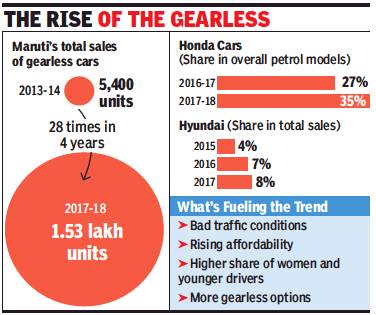
From: Pankaj Doval, Automatic car sales in top gear, June 11, 2018: The Times of India
Blame it on the stress of driving in choked cities, or simply the ease and rising affordability that automatic cars offer, Indians are increasingly going in for these vehicles that give you the comfort of driving without having to worry about gear-shift and clutch.
While being bought only by a few just some years back, gearless cars have seen a substantial growth over the last three to four years, especially as their prices have become more affordable and their performance has gone up manifold — the mileage is equal, or even a little more than the conventional manual variants.
The introduction of lowcost gearless technologies such as AMT (automated manual transmission) by top carmaker Maruti in mass models, such as the Alto, has only strengthened the trend, prompting others to also work towards the cheaper technology. Hyundai will be launching an AMT version in its all-new small car (Santro replacement) that it drives in towards the end of this year.
The numbers are telling: Maruti, which sold just around 5,400 gearless cars four years back, has seen its sales jump to over 1.5 lakh cars in 2017-18. This is now nearly 10% of the company’s annual sales. The company clearly expects more sales of the gearless cars. Maruti Suzuki director (marketing and sales) R S Kalsi says, “With enhanced awareness and deeper penetration, we aim to sell over two lakh cars with AMT in 2018-19.”
Expectedly, the demand is being generated in metro cities and top towns — where there are higher disposable incomes, but also increasing burden on drivers due to heavy traffic conditions. Cars being used by more than one family member, especially the lady in the house, is also leading to higher sales of gearless cars — which are easier to drive.
Hyundai India sales and marketing director Rakesh Srivastava says, “The percentage of auto is far higher in bigger cities such as Delhi, Mumbai, Kolkata and Bengaluru due to traffic challenges. People associate gearless with stress-free driving.”
Honda Cars India director of sales & marketing Rajesh Goel says, “Mostly, our gearless CVTs (continuously variable transmission) offer better fuel efficiency than manual versions.”
2014, 2015: Car sales, company-wise
The Times of India, Jun 23 2015
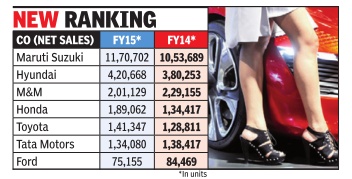
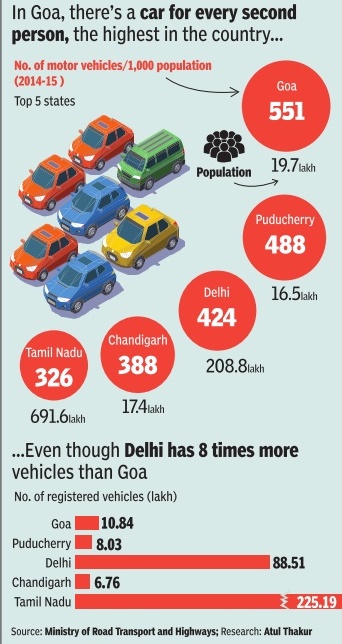
Nandini Sengupta
Toyota Replaces Tata Motors As Fifth Largest Car Maker
M&M lone Indian auto co in top 5
There has been a shift in the pecking order of car and SUV companies in India with the fourth, fifth and sixth spots showing significant changes. According to statistics from the Society of Indian Automobile Manufacturers (SIAM), the top five passenger vehicle companies in India by sale are Maruti, Hyundai, Mahindra & Mahindra, Honda and Toyota. Tata Motors, which was in fourth place in fiscal 2014, slipped to sixth place in FY2015. Ford India is the seventh company in the top sellers' list. As a result of this rejig, M&M is now the only Indian brand among the top five passenger vehicle companies in India.
Indeed, Maruti, Hyundai and M&M have retained their earlier positions in FY2015 as well. Maruti, with 11,70,702 units in sales, remains top seller in FY2015 as well, increasing its tally from 10,53,689 units the year before.
Hyundai, in second position with 4,20,668 units, has also increased its tally from 3,80,253 units in FY14. M&M in third position, though, is lower in terms of sales at 2,01,129 units, down from 2,29,155 units in FY14.
The real change though is in the fourth, fifth and sixth slots. Honda, with 1,89,062 units, is the biggest gainer in the fourth position. It was in the fifth position with 1,34,417 units in FY14. Toyota, at fifth position with 1,41,347 units, has also jumped a slot in FY15. The year before it was sixth with 1,28,811 units.
Tata Motors lost two slots in FY15. With 1,34,080 units, it is now in sixth place whereas in FY14 it was fourth with a nearly similar tally of 1,38,417 units. Ford has remained number seventh, though with a reduced tally -75,155 units in FY15 compared to 84,469 units in FY15.
Industry experts say the change in pecking order is part of a larger churn in the industry as India readies for new emission and safety regulations in two years. N Raja, senior VP & director sales & marketing, Toyota Kirloskar Motor, said, “Customers have started to appreciate and demand safety features in cars, which becomes an important buying parameter. At Toyota, we are happy to contribute to the globalization of the automobile products sold in the country rather than merely chase numbers.“
Others say that individual performances depend more upon the value proposition of the vehicle models and technology will not be market barrier for companies. Vishnu Mathur, director general, SIAM, said, “Once the mandatory regulations come in, the higher technology will be a benchmark for everybody with price-increase a possible small differentiator.“
Purchasing patterns
25% cars sold are off-roaders
Pankaj Doval, 1 of every 4 cars sold is off-roader, Jan 12, 2017: The Times of India
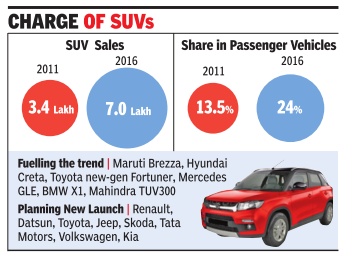
The love of Indians for SUVs is getting stronger by the day and one out of every four cars sold in the country is now an off-roader.
The lure of off-roaders -with high ground clearance, macho looks and relatively-powerful engines -is so strong that their sales volumes have more than doubled over the last five years, outpacing the growth of other segments in the car market, such as compact cars and mini sedans.
Rapidly changing lifestyles, increased inter-city travel and proliferation of newer, and budget-friendly models have fuelled the surge, say companies. “It is a disruptive segment, and it is only going to grow bigger and stronger,“ sa id Rakesh Srivastava, senior VP (sales & marketing) at Hyundai India. The company has tasted success with Creta that now accounts for sale of nearly 8,000 units on a monthly ba sis. “The SUV category is attracting buyers even from sedans and MPVs,“ he added.
Officials say that a higher stance, and patchy road conditions prompt many to opt for SUVs. “Even the prices of the vehicles have been coming down over the years, and they have entered the mainstream of the car industry,“ an official with a leading company said.
Maruti's Brezza, which was launched in March last year, is a case in point. The model has quickly raced on to become one of the fastest-growing cars in the market. It has seen sales of 80,000 units in the nine months of its launch, and boasts of a waiting period, that runs into a few months.
N Raja, director of sales & marketing at Toyota Kirloskar, said that people are “bored“ of hatchbacks and mini sedans.
Mercedes Benz's GLE (priced upwards of Rs 50 lakh) and BMW's X1 (starts around Rs 30 lakh) have seen strong demand in the market too.
2016: car sales
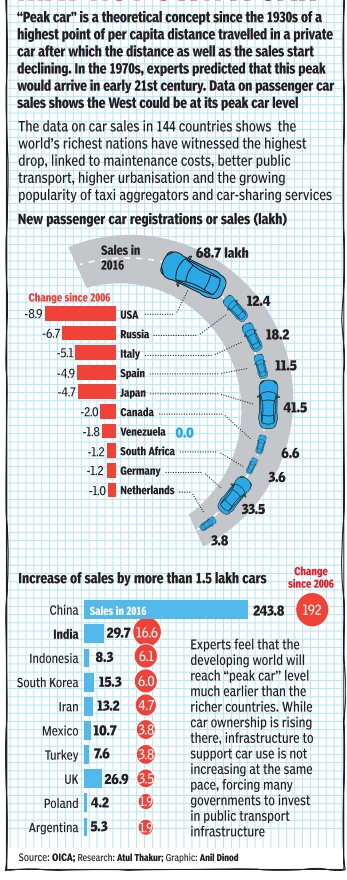
See graphic.
Passenger car sales in 2016 compared with 2006
2016>2018: Luxury cars sales slow down
Pankaj Doval, January 17, 2019: The Times of India
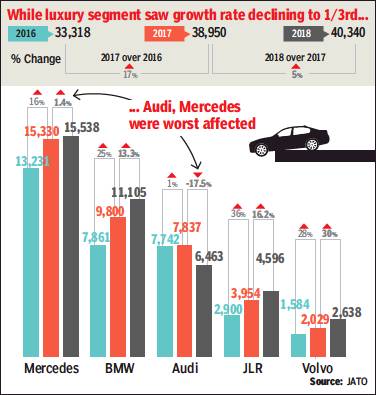
From: Pankaj Doval, January 17, 2019: The Times of India
Luxury car sales have decelerated. With the stock market remaining volatile through most of last year and liquidity pressure growing, reluctant buyers stayed away from new purchases or upgrades, leading to 5% growth in volumes in 2018 against a 17% surge in the previous year. Luxury car makers like Mercedes-Benz and Audi are a worried lot, especially as the liquidity crunch is impacting operations of many of their customers. “A large number of our buyers are from the SME sector. When they cannot even procure working capital comfortably, how can we expect them to buy new cars?” one leading luxury dealer said.
Martin Schwenk, newlyappointed MD & CEO of Mercedes India, said there is nervousness in the market. “I am here since last two months, and I have met our dealers, investors and customers. Honestly, I saw a lot of hesitation based on the overall economic development… (the) hesitation is based on volatility in markets, and the credit situation specifically.”
Rahil Ansari, the head of Audi in India, feels that the pain may be there for some more time. “Luxury car purchase is not the biggest necessity that people have currently.” Ansari attributed Audi’s poor showing to the closure of two dealerships in the Delhi-NCR region after the promoter was found to be indulging in unlawful activities.
Rohit Suri, MD of JLR India, said the second half of 2018 was particularly tough due to tight liquidity condition, higher upfront insurance costs and increased lending rates. A low-key third quarter (July-September) impacted the industry as demand was tight on weaker rupee and high fuel prices. Ravi G Bhatia, India president for global automotive data and consultancy firm JATO, said he expects growth to be difficult in the short term. “The segment is weighed down by the burden of excessive duty and lack of aggressiveness from stakeholders to grow the market. We need strong local strategies.”
2017-18
Pankaj Doval, High fuel prices can hit momentum, say car cos, April 3, 2018: The Times of India
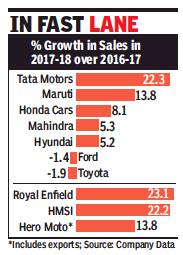
From: Pankaj Doval, High fuel prices can hit momentum, say car cos, April 3, 2018: The Times of India
New models and strong demand helped car and SUV sales shrug off the post-GST blues and close 2017-18 with healthy numbers, though high fuel prices and fears of rise in interest rates may dampen the momentum in the current financial year.
Top car makers such as Maruti Suzuki, Hyundai, Mahindras and Tata Motors reported a growth in sales in 2016-17, even though Toyota and Ford failed to keep pace and slipped by around 2%. Models such as Maruti’s new Swift and Brezza mini SUV, Hyundai’s Verna and Tata Motor’s Nexon fuelled demand.
However, companies say 2018-19 may be challenging as some negative factors have been building up over the past few months.
“The industry is on a positive on the strength of macro-economic factors, backed by stability in policies,” Rakesh Srivastava, director (sales & marketing) at Hyundai India said. “Hardening of interest rates and increase in fuel prices could challenge the growth rate, especially in the entry segment, where cost of acquisition and cost of operations are key factors for buyers.” Companies have also been complaining about GST rates on cars, and say these should be reduced to push demand.
“There are headwinds in terms of impending increase in interest rates, crude prices, and inflation,” Ford India MD Anurag Mehrotra said.
Maruti has been growing strongly and has increased share as it expands model lineup and retail presence. The company is getting new vehicles as parent Suzuki is ramping up Gujarat factory premises and investing in additional production lines.
Sales of Tata Motors have grown 22% in 2017-18, led by new models as well as a low base. New cars such as Nexon, Hexa and Tigor have combined well with the Tiago compact.
2017, 2018: cars sold
Pankaj Doval, Driving new models, car cos start FY19 on a high, May 2, 2018: The Times of India
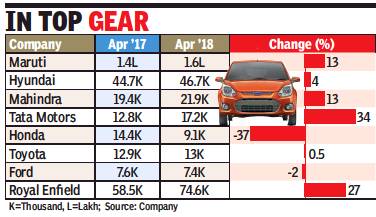
From: Pankaj Doval, Driving new models, car cos start FY19 on a high, May 2, 2018: The Times of India
Car makers started the new fiscal on a strong note even as higher fuel prices and chances of a hike in interest rates may play a spoiler in the coming months. But, forecast of a normal monsoon by the Met department is the silver lining companies are banking on.
Top makers such as Maruti, Mahindra and Tata Motors opened the fiscal 2018-19 with double-digit growth in April as new models and attractive schemes helped sales.
Maruti, which recently drove in the new-gen version of its Swift hatchback, sold a total of 1.6 lakh units in April, a growth of 13% over the 1.4 lakh units sold in the same month last year. Company chairman R C Bhargava has said that Maruti, which will invest Rs 5,000 crore over the next twelve months, expects to grow by double-digit this fiscal after realising a 14% growth last year.
Tata Motors, which has been witnessing a turnaround after encouraging numbers for the Tiago hatchback and the Nexon mini SUV, reported a 34% growth in April volumes at 17,235 units against 12,827 units in the same month last year. “While there were challenges in the market, strong demand for new products led the growth for us,” Mayank Pareek, president of the company’s Passenger Vehicles Business Unit, said. Mahindra and Mahindra, which launched a new version of its XUV5OO SUV, said numbers are higher by 13% at 21,927 units. The company, facing stiff competition from Maruti, Hyundai and Renault, has been working on a revival strategy.
Companies, however, are worried about the impact of higher fuel prices and possible inflationary trends emanating from it. “Increasing inflation trajectory which might weigh on customer’s access and cost to credit, coupled with increasing crude prices, could lead to passenger vehicle industry growing at low single digits,” Anurag Mehrotra, president and MD of Ford India, said. Honda Cars had a 37% decline in volumes, but this is because the company did not deliver the older-generation Amaze to dealerships. The new Amaze is hitting the roads soon, a company official said.
Fuel prices are at record levels at this moment, which companies fear may dampen customer demand. Another point of worry for carmakers is the slowdown in top metros such as Bangalore, Mumbai and even Delhi where generating demand is getting tougher.
The sales in these volume heavy cities have been impacted due to rising acceptance of shared mobility (through companies such as Ola and Uber) and rapidly-improving metro train network. As the infrastructure gets choked, many people prefer to move by cabs rather than driving on their own and getting stuck in traffic jams. Online shopping and the ease of ordering from home is also making people re-think when they consider a new car.
Car sales starting to fall in big cities
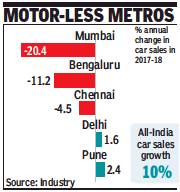
From: Pankaj Doval, Jams, app-based cabs, e-shopping drive down car sales in big cities, April 29, 2018: The Times of India
Traffic jams, parking problems, app-based cabs, online shopping and fast-spreading Metro rail networks have resulted in car sales starting to fall in big cities, something many hoped for but few expected to become a reality.
City-specific numbers accessed by TOI from industry sources show car sales dropped 20% in Mumbai in 2017-18 — 97,274 cars sold during the year versus 1.22 lakh in the previous year. Bengaluru, with its choked infrastructure but younger and tech-savvy population, saw car sales fall 11%. The Karnataka capital is India’s second-largest car market after Delhi.
Delhi car mkt sees marginal growth of 1.6%
India’s largest car market, Delhi, recorded a marginal growth of 1.6%, and that too because of the lower base of 2016-17 when diesel car sales were banned for a few months.
Falling or flat metro markets in a year when all-India sales grew by 10% is seen as an evolutionary trend. “Metro cities are seeing challenges in volume growth on account of rising trend of shared mobility through platforms such as Ola and Uber,” says Rakesh Srivastava, director (Sales & Marketing) with Hyundai India. “The other key factor is rapidly growing Metro transportation, especially to key employment hubs such as Gurgaon and Delhi. People prefer to take Metro than driving and getting stuck in jams.”
Industry officials also point to a growing trend of people not planning to buy or sell a second car. “If the woman... of the house earlier had a car for household chores, she now either orders online or calls for an app-based cab. There is no hassle of driving, looking for a parking spot, or getting stuck in traffic,” says an industry veteran. N Raja, deputy MD at Toyota Kirloskar, says fewer purchases by drivers of fleet operators and shared mobility platforms have also contributed to the decline. This has happened because firms such as Ola and Uber have brought down driver incentives.
Maruti Suzuki made the top- 5 passenger vehicle models
Nandini Sengupta, Maruti owns road to top-5 seller list, April 12, 2018: The Times of India
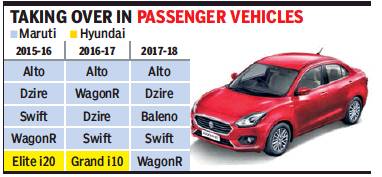
From: Nandini Sengupta, Maruti owns road to top-5 seller list, April 12, 2018: The Times of India
Dzire Sales Accelerate, Close Gap With Leader Alto In FY18
Maruti Suzuki has ended fiscal 2017-18 with a clean sweep of the top five selling passenger vehicle models in India. The company’s Alto has topped the all-India sales tally for the fiscal with 2.5 lakh units, followed by Dzire (2.4 lakh), Baleno (1.9 lakh), Swift (1.7 lakh) and WagonR (1.68 lakh).
While Maruti’s dominance in the top-10 best-selling models list is not new, this year the difference between sales numbers of the mass market entry-level Alto and the compact sedan Dzire has come down from more than 40,000 units in FY16-17 to a mere 18,415 units. While Alto, too, has grown by 7%, the reason for the reduction in sales gap is due to Dzire’s much higher growth at 20%. Indeed, the only model that did not grow in the top-5 list is Maruti’s WagonR, which saw sales dipping from 1.72 lakh units in FY16-17 to 1.68 lakh this time round.
A look at the sales tally comparison between FY16-17 and FY17-18 tells the story: Maruti Suzuki clocked the highest growth in the top-5 list in the Baleno, which grew a staggering 58% year-on-year. The second-highest growth was in Dzire sales. In comparison, older models like Swift and Alto showed modest growth. While Swift grew just 5.4%, WagonR actually contracted by 2%.
Maruti also has two more models in the top-10 list — Vitara Brezza at No. 7 and Celerio at No. 10. While Vitara Brezza sales grew nearly 37% to 1.5 lakh units, Celerio sales actually contracted by almost 3% to 94,721 units.
The growth patterns show the trend: Although the entry segment is still growing on the back of the Alto’s popularity, the growth spurt is much lower than what’s being totted up by the SUV and sedan brigade. Even a not-so-new Dzire has clocked a significant double-digit growth rate, showing the increasing preference for ‘bigger’ vehicles. Clearly, India still loves the hatch, but is beginning to aspire for other vehicle types like sedans and SUVs.
2017> 2018: SUV models that sold well/ badly
Nandini Sen Gupta, Not all SUV models are hot selling, June 25, 2018: The Times of India
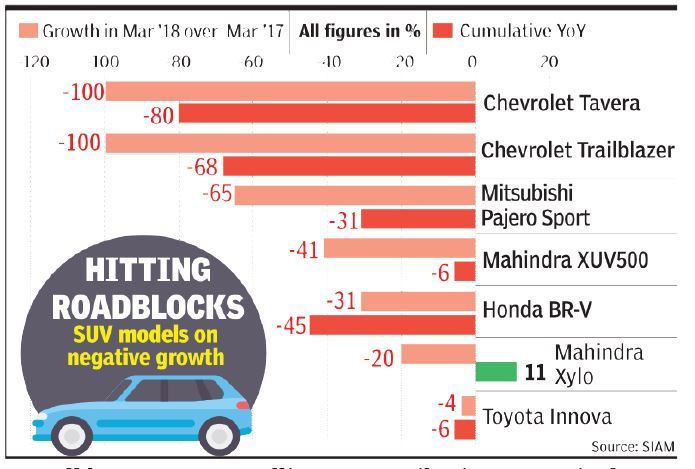
From: Nandini Sen Gupta, Not all SUV models are hot selling, June 25, 2018: The Times of India
The SUV/UV segment may be burning serious rubber on Indian roads but not all products are hitting top gear.
According to Society of Indian Automobile Manufactures (SIAM) data, a good half a dozen well-known models is languishing both month-on month and year-on-year (YoY). This includes the likes of Mahindra XUV500, Toyota Innova, Honda BR-V, Chevrolet Trailblazer, Chevrolet Tavera and Mitsubishi Pajero Sport. The stats also show not all segments in the SUV spectrum are growing. The 4.4-4.7m segment under the Rs 15-lakh price band is degrowing in double digits. While Chevrolet models Tavera and Trailblazer are languishing after parent GM India decided to pull out of India, the other three on the list are well-known, strong selling products. Take the Toyota Innova, whose numbers dropped 6% in FY18 compared to FY17.
Toyota officials say this dip is usual once the launch spur wears out. Toyota Kirloskar Motor deputy MD N Raja said, “The Innova Crysta was launched during May 2016. The initial new product launch period contributing to spur in the customer buying patterns plays a lead role. Innova Crysta remains a segment leader YoY capturing an average of 40% market share. We witnessed a sales jump of 34% with around 17,800 units during this financial year, starting April-June 2018 (as on date), reflecting a further increased market share of 4% in its segment.”
In the case of the Mahindra XUV500, the dip is due to the stock getting over before the launch of a refreshed version, said company officials. M&M chief of sales and marketing (automotive division) Veejay Nakra said, “In FY18,we had taken conscious steps to phase out the old model with planned lower wholesale in Q4 (especially for March). This resulted in a slight degrowth for the brand in FY18.
Car marketers say the SUV market is getting fragmented and hence sub-segments are performing differently. Nakra said, “The sub-segment, such as compact SUVs, has seen higher growth as compared to a full-sized UV segment. Additionally, external challenges such as GST and cess increase in September have impacted volumes of full-sized SUVs in H1 FY18,” he added.
2017, 2018: sales in metros decline
Growing traffic congestion and the rising popularity of shared mobility players such as Uber and Ola have lowered the demand for new cars in the top metros of the country, Maruti Suzuki said.
Demand has further been squeezed as fuel prices continue to remain high and insurance premiums and vehicle financing rates get dearer, the company — which accounts for one out of every two cars sold in the country — said. “The metro markets are currently under pressure in terms of growth. There are concerns,” RS Kalsi, senior director (sales & marketing) at Maruti Suzuki, told TOI here. “Traffic congestion, (and) shared mobility are some of the factors that are impacting the generation of demand,” he said while spelling out what had impacted the sales numbers of car makers in the metro cities.
Urban markets lag rural in car sales for 2nd year
If a customer decides not to buy, we can’t do anything in that situation.” New vehicle sales have been under pressure and Maruti has witnessed flat growth over the past two months (year-onyear). The weak numbers have been particularly alarming as they have come during the festive period which normally is a bumper period for carmakers.
Kalsi said that urban markets, which provide a larger share to the sales of carmakers, are feeling the pinch. They lag the rural markets which are growing at a faster pace. “The rural markets have grown by 12-14%, while the urban markets are moving slower. The urban growth is estimated at 2-3%.”
This will be second year when the urban markets — which provide the bulk of sales in India — are proving to be laggards. In 2017-18, sales had fallen by 20% in Mumbai, 11% in Bengaluru, and 4.5% in Chennai. Delhi and Pune, also heavy-volume markets, could manage only a 2% growth.
Speaking about the sales pressure on the retail front, Kalsi said the festive season has “not been on expected lines” this year on account of the slowdown pangs. “The sales were not on expected lines, and the growth was on expected projections. We grew 6%, which was not very good. We were expecting to move up by doubt-digits, and could only grow by around half.”
Discounts have been high in the industry as companies try and lure buyers to showrooms. Maruti has already said that discounts were higher by nearly 20% in the second quarter of this fiscal against the same in the previous year. “The average discount was around Rs 15,500 in the second quarter of last fiscal, and the same was around Rs 18,500 in the same period of 2018-19,” Kalsi said.
Pressure due to low demand has been felt across vehicles categories, but has been particularly strong for first-time buyers. “When the sentiments are down, every category witnesses pressure.” Kalsi said it is “difficult to provide a forecast” on how the market would behave in the new fiscal, considering the variety of factors that have been pulling down the numbers currently. However, he pointed out that there were certain positives that were also building up in the market. These include the growth in GDP, the slight softening in fuel prices and the crop support prices announced for the farmers. “But at the end of the day, the sentiment is determined by the sum total of all the factors.”
Maruti drives in the new-gen Ertiga
Maruti Suzuki drove in an all-new version of its MPV Ertiga with an entry price of Rs 7.44 lakh. While the petrol variants of the new Ertiga are costlier by up to Rs 71,000 from the outgoing version, the diesel versions are costlier by up to Rs 20,000. The petrol variants, including two automatic transmission trims, are powered by an all-new 1.5 litre engine and are priced between Rs 7.4 lakh and Rs 9.9 lakh. The diesel variants carry the same 1.3 litre engine as the earlier version and are priced between Rs 8.8 lakh and Rs 10.9 lakh (all prices ex-showroom Delhi).
2017> 2018: slowing demand
Pankaj Doval, Auto cos see tough times ahead on slowing demand, April 2, 2019: The Times of India
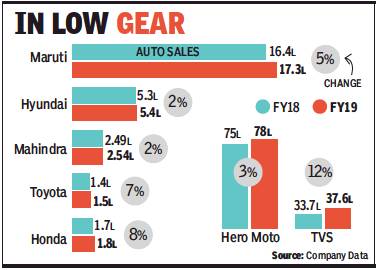
From: Pankaj Doval, Auto cos see tough times ahead on slowing demand, April 2, 2019: The Times of India
Weak Rural Mkts, Rising Shared Mobility Play Spoilsport
Lower demand in rural markets slowed down the auto industry towards the end of 2018-19 as car, SUV and two-wheeler makers faced tough times, with the outlook looking more challenging over the coming months.
Top companies such as Maruti, Hyundai, Mahindra & Mahindra, Toyota and Honda managed a single-digit growth for the entire financial year, and sales for some of them have been in the negative zone in the last few months.
Two-wheeler makers have seen an equally challenging period as top player Hero Moto’s volumes have been in the red for the past four months (decline was 20% in March), even though sales for full financial year were up 3%. Things have been equally challenging for other manufacturers, such as Honda Motorcycle and Scooter India (HMSI), Bajaj Auto and TVS, which have also been under slowdown pressure.
On the passenger vehicle front, the growth is expected at 3% this fiscal, a far cry from initial forecast of 8-10% at the beginning of financial year. Higher cost of insurance, dearer and tougher financing scenario, and relatively stronger fuel prices have dampened the sentiments in the car and SUV space. Also, with the top metro markets such as Delhi, Mumbai, Bangalore and Chennai witnessing a pressure on new demand generation on a variety of factors — including due to increasing population of shared-mobility players such as Ola and Uber — things are expected to remain tough.
A bigger worry for the passenger vehicle industry has been market conditions remaining tough, despite companies driving in new models and offering attractive discounts and freebies. Except for October last year, year-on-year sales growth has been in the negative territory since July. New models such as Hyundai’s Santro mini, Mahindra’s Marazzo MPV and Maruti WagonR hatch have not been able to bail out the industry.
Market analysts said with general elections around the corner, buyers are “in a negative mode as poll-related political mud-slinging gets harsher, creating an uncertain economic and political situation.” Vishnu Mathur, director general of industry body Siam, said he expected a turnaround only after elections. “The problem is that even retail sales are in the negative zone now. People are generally hesitant during election times.”
N Raja, deputy MD of Toyota Kirloskar Motor said that consumer spending has weakened in the pre-election phase and business sentiments have dampened temporarily.
2017> 2018: Dzire replaces Alto as no.1
Dzire overtakes Alto as top-selling car, December 26, 2018: The Times of India
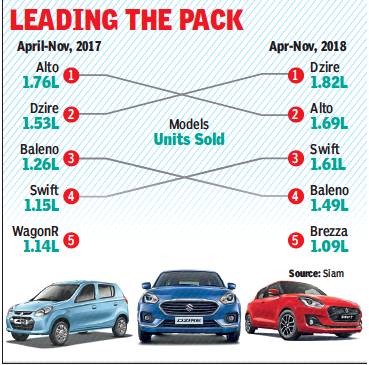
From: Dzire overtakes Alto as top-selling car, December 26, 2018: The Times of India
Rides On Buyers’ Growing Aspirations And Desire For A Better Status Symbol
Indian car buyers are upgrading, and Maruti’s Alto — the country’s largest selling hatchback — is no more the Number 1 seller. Bigger sibling Dzire has emerged as the top-seller in April-November 2018, riding on growing aspirations of Indians for a car-with-theboot and a new design.
While Alto sold 1.69 lakh units in first eight months of the current financial year, Dzire surged ahead with 1.82 lakh units. For Alto, numbers declined by 4%, but higher-priced Dzire saw volumes go up by 19%, according to industry body Siam.
The change indicates desire of Indians for a better status symbol, say market watchers. It also shows growing fatigue that has set in for Alto, one of the most-prominent cars after (now phased out) Maruti 800. While Dzire has been upgraded, a fresh version of Alto is in the works and may see a new life only next year.
Ravi G Bhatia, India president for global automotive data and consultancy firm JATO, said the trend is here to stay. Also, more features in relatively bigger vehicles, and their growing affordability, are attracting a lot of buyers. “Income has gone up for customers, but car prices have not increased in the same proportion. So, bigger cars are more comfortable,” Bhatia said. “Smaller car models are more concerned about giving an attractive entry price, and compromise in certain features such as infotainment and safety. So, a lot of convenience is seen in the mid-size models.”
Maruti will not be very worried at the outcome as its models command a major share in the top-selling passenger vehicle segment in the country. Other models to break into the fat-volume brigade are from Hyundai (not in the top 5), though the gap between rivals is large.
Hyundai’s premium hatchback Elite i20 sold 92,817 units in April-November to be the seventh best-selling passenger vehicle model. It was in the eighth position in the year-ago period, clocking 89,988 units.
WagonR, yet another model from Maruti, is in the sixth position with 1.07 lakh units, down from fifth last year when it registered sales of 1.14 lakh units.
Hyundai’s compact car Grand i10 is at the eight position this year, posting sales of 88,016 units, down from sixth position in the same period last year when it clocked 1.03 lakh units. Hyundai’s SUV Creta sold 84,701 units, retaining the ninth spot. It had sold 71,808 units in the year-ago period.
Completing the top-10 best-selling passenger vehicle model is Maruti’s compact car Celerio with 70,079 units. It was at the same rank in the year-ago period with 66,682 units, according to SIAM data.
2018: After decades, a sedan is the bestselling car
Pankaj Doval, January 22, 2019: The Times of India
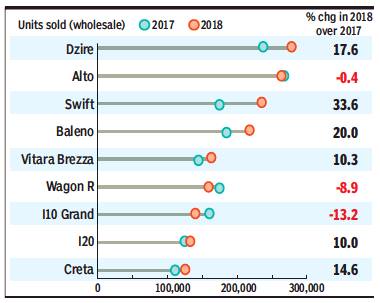
From: Pankaj Doval, January 22, 2019: The Times of India
Buyers’ Desire Goes Beyond Small Vehicles
India’s love for its smallest cars seems to be waning. In 2018, Alto, which was the number 1 car for 14 straight years, lost its crown to Dzire, Maruti’s compact sedan. Not only was it beaten by the bigger car, it sold around a thousand fewer units over the year. In rival Hyundai’s stable, too, sales of Grand i10 fell by about 13%, while its bigger siblings, i20 and Creta, saw robust sales growth of about 10% and 15%, respectively.
Although Dzire and its hatchback version, Swift, have outsold Alto for a few months in past years, this is the first time a sedan has been India’s biggest-selling car for a whole year since the Ambassador ruled the roost decades ago, before the rise of the Maruti 800. With disposable incomes and aspirations rising, is this a sign of the times?
“The Indian car buyer is upgrading, and he wants the best for what he can afford,” said industry analyst Jnaneswar Sen. The trend also shows that first-time buyers are not increasing as quickly as those who are upgrading, or buying another car, he added. “So, the upper segment is growing, but the entry car market is shrinking.”
Social scientist and advertising professional Santosh Desai said the trend is here to stay. “This shift has been in the making for a while… Incomes are rising, and you have gone through the cycles of the first car,” Desai said, adding, “The Indian customer has begun to value comfort and some higher-order needs, and is willing to pay for them.”
Industry officials said buyers now value safety and comfort as much as design. “Features like airbags and ABS are turning out to be very important as buyers get more safety-conscious. In terms of comfort, features like power windows, and touch-screen controls for in-car entertainment, have a strong pull,” a top official with a leading carmaker said.
Sales of Dzire grew by 18%, Alto fell 0.5%
Dzire, a sub-4-metre sedan launched in 2008, has been one of the strongest models for Maruti from the very beginning. It is priced Rs 5.7 lakh onwards, as against Alto’s Rs 2.6-lakh starting price. While Dzire’s sales grew by 18% in a year when overall passenger vehicle sales grew by 5%, demand for Alto — the so-called “people’s car” — fell by 0.5%, numbers accessed by TOI show.
Desai said people desire a car with a boot not only as a status symbol but also as a practical need. “We carry enormous amounts of luggage when travel, thus option of adding a boot is legitimate. It is a significant factor.” Easy access to finance may also explain the robust demand for bigger vehicles, experts said. Dzire’s more expensive stablemate Brezza took fifth position, ahead of WagonR. It had finished seventh in 2017. Hyundai Creta, which retails upwards of Rs 9.5 lakh, was the ninth-largest selling model.
2018> 19: sales lose steam
Pankaj Doval, Car, SUV sales lose steam as sentiment weakens, March 9, 2019: The Times of India
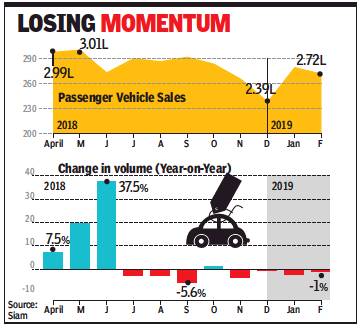
From: Pankaj Doval, Car, SUV sales lose steam as sentiment weakens, March 9, 2019: The Times of India
New models and attractive discounts have failed to enthuse car and SUV buyers, who are staying away from the market as negative sentiments continue to strengthen.
Sales of passenger vehicles have been negative (year-on-year) in seven of the past eight months, reflecting the nervousness among buyers. Overall, car and SUV sales have grown by 3% in eleven months of 2018-19, a far cry from the 8-10% growth forecast made at the beginning of the year.
Market analysts say with general elections around the corner, buyers are “in a negative mode as pollrelated political mud-slinging gets harsher, creating an uncertain economic and political situation”.
No registration for taxis in the past one month — due to problems with insurance requirement — has also hit demand.
“Many RTOs are asking for a three-year insurance. while insurance companies do not have such a product. Taxi sales are 10% of overall sales and chip in with nearly 27,000-30,000 units every month.” Any credible revival is expected only after the poll results.
2013-19: SUV sales drop in 18-19
Nandini Sengupta, After 5 yrs of growth, SUV sales hit a bump, March 11, 2019: The Times of India
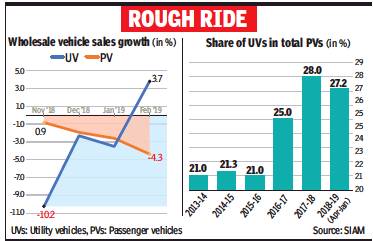
From: Nandini Sengupta, After 5 yrs of growth, SUV sales hit a bump, March 11, 2019: The Times of India
Sharp Fall Since Nov | MPVs Rebound In Feb
Is the SUV craze fading? After rising steadily for five years, sales of utility and crossover vehicles have fallen sharply since November. And though overall utility vehicle (UV) wholesales have rebounded in February, it is on the back of improved MPV sales rather than SUV volumes, which remain negative. The UV share in overall passenger vehicle sales this financial year is also down marginally. In fact, segment leaders Suzuki Vitara Brezza and Hyundai Creta were among the hardest hit in December.
In 2013-14, only 1-in-5 passenger vehicles sold in India was a utility vehicle. By 2016-17, their share had increased to 1-in-4. And last fiscal, it peaked at 28%. However, figures for the April-January period of this financial year show their share is down to 27.2% (see graphic). While car sales have also slowed since November, the dip in SUV sales is more marked. In January, SUV sales were down 3.5% compared to 2.6% for cars. In December, 2.3% fewer SUVs sold compared to 2% fewer cars. And in November, when car sales fell 1%, SUV sales were down 10.2%.
In February, however, total UV (including SUV and MPV) wholesales rebounded on the back of aggressive billing by companies before the year-end and good performance by the MPV segment. SIAM data shows total UV sales were up 3.7% in February, while cars were down 4.3%. For April-February, cars were up nearly 3%, while total UVs (including MPVs) were up 2%.
Suzuki Vitara Brezza, the best-selling compact SUV, saw sales crash from 14,378 units in November to 9,667 in December, although it rebounded to 13,172 units in January. Second placed Hyundai Creta sold 9,677 units in November; 7,631 in December and 10,314 in January.
Industry experts say both the compact and the mid-sized SUV segments are affected. These have the maximum models and account for the bulk of sales. In the compact SUV segment, sales were down by 5% — to 1,44,203 from 1,51,141 units — in the November-February period. In the mid-sized segment (Hyundai Tucson, Jeep Compass, etc), sales fell 19% to 10,105 units from 12,618 in the period. Sales of medium premium SUVs (Toyota Fortuner, Ford Endeavour, etc) were down 9%, to 10,580 units from 11,656 units. However, premium SUVs, such as Land Cruiser and Prado, sold 37 units as against 30 earlier.
Sales have fallen due to the overall subdued consumer sentiment, said Mahindra & Mahindra president (automotive sector) Rajan Wadhera. “In December, a call was taken to focus on retail to bring dealer stocks to normal, and this has resulted in low performance. The availability of finance is an issue.” He said buyers are avoiding highpriced SUVs.
Other experts said people may be delaying buying to wait for BS-6-compliant vehicles. Also, SUVs, which mostly have diesel engines, may be looking less attractive because fuel prices are again rising and diesel is inching closer to petrol.
2019

From: September 26, 2020: The Times of India
See graphic:
Top 10 auto markets based on passenger car- light vehicle registrations in 2019
Automoblies (used): sales
2018: 50% growth
Nandini Sengupta, Used car market sees 50% growth in a year, November 9, 2018: The Times of India
The new vehicle market may not have had a great festival season this year, but the fireworks are going off for the used car segment.
According to top players in the organised used car market like Mahindra First Choice Wheels, OLX or Truebil, the segment saw a growth rate of 40-50% this year. Ironically, the expansion came on the back of the rush of car and SUV launches this year. With new models rolling out, their earlier versions see a sharp drop in prices in the used car pool, making them bargain buys. Also, with every launch, more vehicles come into the used car market, which is a supply constrained business. Hence, the surge in demand, say marketers.
Online used car marketplace Truebil’s co-founder & marketing head Shubh Bansal said, “In the January-September period this year, there have been as many as 27 new/facelift model rollouts. So the price of the same model in used cars has dropped significantly. Those that are doing very well are Suzuki Swift, Honda City and the Maruti Alto (with the launch of the new Santro, prices of used Altos have dropped).”
Organised used car market leader Mahindra First Choice Wheels has seen 40-50% growth over last year. The company’s CEO Ashutosh Pandey said, “The market has been growing quite well. So this wasn’t unexpected, particularly since there has been a lot of new car inventory due to low growth in that market. As the used vehicle business is a supply constrained market, the increase in stocks boosted growth.” Additionally, while fuel price — a factor that affected new car sales — has also impacted the used vehicle segment, the “capital cost of the asset” has come down sharply enough to “make used cars a compelling value proposition”, he added.
Indeed, the plethora of launches or facelifts have created a phenomenon of “almost new cars” turning up in the used vehicle pool, said OLX India VP (cars category) Sunny Kataria. “The supply of used cars that are less than 2 years old with just 15,000-20,000km clocked has grown sharply,” he said. “For this category, supply is up 20% over last year and demand is up 50% year-on-year.”
New models make their earlier versions bargain buys. And with every launch, more vehicles come into used car market, increasing supply and boosting demand
Automobile sales, by region
2017: Delhi got 7% of all vehicles sold
Dipak Dash , Delhi got 7% of all vehicles sold last yr, January 28, 2018: The Times of India
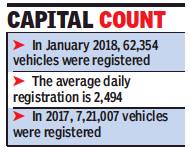
From: Dipak Dash , Delhi got 7% of all vehicles sold last yr, January 28, 2018: The Times of India
Automobiles in Delhi, January 2018, some facts
About 7% of vehicles sold in the country last year were registered in Delhi, choking the city's already cramped road infrastructure. While the national capital is home to a little over one per cent of India’s population, it accounts for nearly five per cent of the total registered vehicles.
According to the details available from government’s national vehicle database “Vahan”, on an average around 2,500 were registered daily in January itself in the national capital. In 2017, the average daily registration of vehicles in Delhi was 1,975. “The penetration of vehicle on Delhi roads is much higher considering that a large section of people working in Delhi are staying in the suburbs and their vehicles are registered in the neighbouring states of Haryana and Uttar Pradesh. A compilation of total registration of vehicles in immediate neighbouring areas of Delhi will show how the situation is getting grimmer,” said a government official. He said the huge concentration of private vehicles are choking the internal roads and those connecting the suburbs with the national capital.
Data also show that little over 65% of the vehicles registered in Delhi are two-wheelers while the share of such vehicles at the national level is around 75%. Transport ministry officials said until and unless there is adequate public transport system backed with last-mile connectivity, the government can’t expect people to stop using private vehicles.
According to transport expert Anil Chikkara, Delhi has some unique characteristics unlike the major cities where people usually travel to central business districts (CBDs) for work. “Here, we have polydirectional flow of traffic and hence just public transport won’t suffice. This must be supplemented by robust lastmile connectivity,” he said.
In fact, a study carried out by Centre for Science and Environment last year had found that the average morning and evening peak speed on 13 major arterial roads was 28 kmph and 25 kmph while off-peak speed was about 27 kmph.
“Rather than fixing the problem, successive governments have put more focus on expanding roads and building flyovers to stagger the problem,” said traffic expert Rohit Baluja.
Ban/ restrictions on old vehicles
Commercial vehicles: Govt caps life at 20 years
Dipak Dash, Govt caps life of commercial vehicles at 20 yrs, March 17, 2018: The Times of India
The government has decided to cap the life of commercial vehicles to 20 years beginning 2020. This means vehicles such as taxis, three-wheelers, trucks and buses that were registered before 2000 cannot ply on road from April 1, 2020 and subsequently any commercial vehicle reaching the 20 year age limit will be automatically de-registered.
The vehicle scrapping policy was approved by a high-level meeting at prime minister’s office (PMO) on Friday. The policy won’t cover private vehicles, meaning there will be no mandatory phasing out of cars and twowheelers irrespective of their age as long as they comply with emission norms.
The government expects at least seven lakh commercial vehicles registered before 2000 (when Bharat Stage-I emission was introduced) will be off the road in 2020. According to different researches and studies, pre-BS-I commercial vehicles emit pollutants 25 times more than the BS-IV vehicles.
Sources said the government raised the cap from an earlier proposed 15 to 20 years considering that in most of the cases these vehicles are sold and resold to third parties, a majority of whom may find it difficult to buy a new vehicle.
Section-59 of central motor vehicles act empowers the transport ministry to fix the age limit of motor vehicle for each category of vehicle. It remains to be seen how government deals with the court ruling against plying of all 10 and 15-year-old diesel and petrol vehicles in Delhi and its suburbs since now there will be a policy in place.
In its bid to help the owners of old vehicles, the government will put the proposal for giving some tax relief to those who scrap their vehicle and buy a new one against it. A proposal to keep the sale of old vehicles as scrap out of the GST regime would be placed before the GST Council. There will also be a proposal to reduce the GST rate from the present 28% to 18% for buying a new vehicle in lieu of the scrapped one.
TOI has learnt that vehicle manufacturers have indicated they would offer special discounts to buyers who scrap their old vehicles. Soon there will be talks to work out the modalities. Moreover, those who go for buying an electric vehicle against the scrapped one may also get some incentive under government’s FAME scheme.
Steel ministry has already set up a scrapping centre and three more will come up in the next couple of years so that people have option to sell their retiring vehicles.
Scrapping policy: MHCVs, before 2001
The Indian Express, December 16, 2016
Amitabh Sinha
Scrapping 15-yr-old vehicles: Plan is to exempt cars, phase out buses, trucks
The ministry cites a study by AT Kearney which shows that there are 11.2 lakh MHCVs which are more than 15 years old and contribute to 34 per cent of the pollution.
According to the Motor Vehicles Act, LMV is defined as a transport vehicle with an unladen weight that does not exceed 7,500 kg, a definition that covers the entire range of passenger cars and SUVs and MUVs that are currently available.
The Ministry of Road Transport plans to retire only medium and heavy commercial vehicles (MHCVs) — and not passenger cars — that are more than 15 years old under a proposed vehicle scrapping policy submitted to a Committee of Secretaries for approval.
“In respect of LMVs (light motor vehicles), it is estimated that about 40 lakh cars are plying on the road that are more than 15 years old. These vehicles are estimated to contribute about 3 per cent of vehicular pollution. Since the overall contribution of cars to emissions is significantly less, hence they are not being considered under this programme,” says the Ministry. Watch what else is making news:
According to the Motor Vehicles Act, a light motor vehicle or LMV is defined as a transport vehicle with an unladen weight that does not exceed 7,500 kg, a definition that covers the entire range of passenger cars and SUVs (sports utility vehicles) and MUVs (multi utility vehicles) that are currently available. This includes the Toyota Innova (weight of 1870 kg for the heavier auto version), Mitsubishi Pajero (1,935 kg), Ford Endeavour (2,357 kg) and Mercedes Benz GL Class (2,535 kg). All vehicles weighing more than 7.5 tonnes are MHCVs.
The ministry cites a study by AT Kearney which shows that there are 11.2 lakh MHCVs which are more than 15 years old and contribute to 34 per cent of the pollution. In all, MHCVs accounted for 2.5 percent of country’s total fleet but contributed over 60 per cent of the air pollution, it says. Vehicle emissions contribute to rise in levels of toxic carbon monoxide, hydrocarbons, nitrogen oxides and particulate matter. Since it would be very difficult to impose a mandatory retirement of vehicles, the ministry argues, it plans to provide some respite and encourage retirement in this segment by proposing a voluntary vehicle modernization programme followed by a regulation on the life of vehicles.
For the first two years, vehicle owners would be given incentives in the form of scrap value, direct transfers capped at 4-5 per cent of the cost of basic model as well as cash discounts of 4-5 percent from the original equipment manufacturers. In effect, these would amount to a benefit of about 15 per cent in lieu of surrendering an old 16-tonne truck, says the illustration in the proposal. The previously proposed incentive by way of 50 per cent exemption in excise duty has been removed as the Finance Ministry has said that it would not be practical in view of the country’s shift towards a GST regime.
However, the 15-per cent incentive would be limited to the first two years to help in “smooth progression to regulatory regime of capping the life of the vehicles by the transport industry”. Then on, vehicle owners would be given sufficient time to look for viable replacements through a phased capping of the life of MHCVs to 18 years as on April 1, 2018; 16 years as on April 1, 2019 and finally at 15 years from April 1, 2020. Section 59 of The Motor Vehicles Act empowers the government to specify the life of a motor vehicle reckoned from the date of its manufacture. At present, an owner pays a one-time tax for lifetime but needs to get the fitness certificate renewed after 15 years to continue running it.
The government had told the Supreme Court this July that a new policy to combat pollution including scrapping of old vehicles and a scheme to replace about 28 million automobiles registered before March 31, 2005 was underway and would be implemented soon.
State-wise
Kerala (urban): 10-year-old diesel vehicles nixed
The Times of India, May 24 2016
10-year-old diesel vehicles to go off Kerala city roads
Mahir Haneef & MK Sunil Kumar1
The National Green Tribunal's bench at Ernakulam ordered that no diesel vehicle older than 10 years should be allowed to ply in the six major cities of Kerala. It also temporarily banned registration of new diesel vehicles over 2,000cc. Looking at possible alternatives, it asked the government to inform it whether enough CNG is available for running vehicles in the state.
Cities mentioned in the order are Thiruvananthapuram, Kollam, Kochi, Thrissur, Calicut and Kannur.
The tribunal's order made it clear that any vehicle found violating the directive after 30 days would be liable to a fine of Rs 5,000 per violation as environmental compensation. Such compensation can be collected by traffic police or State Pollution Control Board. Funds so collected should be maintained separately by the pollution control board and spent only for betterment of environment in the cities where the ban would be in force, the order stated.
The directions were issued in an interim order by Justice Swatanter Kumar and expert member Bikram Singh Sajwan in response to a plea filed by Lawyers' Environmental Awareness Forum through advocate Jacob Abraham.
In cities like Kochi and Kozhikode, privately owned buses are the main mode of public transport and constitute a major chunk of vehicles on the road. Of around 16,000 private buses in the state, 9,000 are above 10 years old. Around 85% of the 90,000 trucks in the state are above 10 years old.
Behaviour of car buyers
Indians, Chinese vs. the rest/ 2017
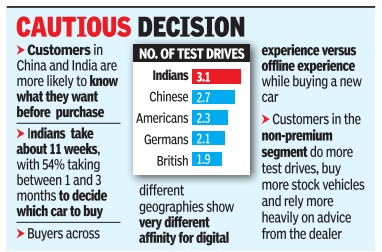
Indian car buyers like to try out the maximum number of test drives before buying the vehicle of their choice. At 3.1, Indian buyers top the list followed by the Chinese (2.7), Americans (2.3), Germans (2.1) and the British (1.9). Those are the findings of a recent study by consultancy firm Bain & Co, which tracked the behaviour of car buyers between digital and offline experiences across different auto markets globally .
The study -titled `The Future of Car Sales Is Omnichannel' -also found that car buyers in India and China have more touch points throughout (about 7.5 and 7 on average, respectively , compared with about 6 in mature markets) and assign different importance to individual touch points. Customers in China and India are also more likely to know what they want before they go in for a purchase, with up to 75% of all premium customers saying they were fully determined on brand, model and price before visiting the dealer.
The study has shown that car buyers across different geographies show very different affinity for digital experience versus offline experience while buying a new car. Consumers in developing economies like China and India generally show a strong affinity for online touch points, but they tend to start their buying episodes offline, and more than a third start at the dealer. In the US, 54% of episodes start online, and in the UK the percentage is nearer 60%.
Their online and offline preferences also determine other consumer behaviour, including time taken to decide on what car to buy. Buyers in the US are the fastest to decide according to the study (8 weeks on average, 51% in less than a month). Germans take more time (10 weeks, with 47% taking between one and three months), followed by Indi ans (11 weeks, with 54% taking between one and three months).In developed markets, younger buyers take longer to decide, while in China and India differences among age groups were less significant, said the study. The study also found that premium car customers like to engage more with dealerships than mass-market customers.“Premium car customers have about 25% more interactions during their buying episodes than mass-market customers,“ said the Bain study.
In contrast, non-premium customers are less decided on specific brands, with 10-15% of non-premium buyers in Germany, the UK and the US completely open to brands, compared with only about 5% of premium buyers who are similarly flexible.Also, customers in the non-premium segment do more test drives, buy more stock vehicles and rely more heavily on advice from the dealer -perhaps because they are more price-sensitive and thus more likely to accept the most attractive offer, said the study.
BS IV
2017/ SC bans sale, registration of BS-III vehicles
AmitAnand Choudhary, 8.2L Unsold Units To Be Exported Or Scrapped, Mar 30, 2017: The Times of India
SC bans sale, registration of BS-III vehicles from April 1
Drawing a strong line on environmental issues, the Supreme Court banned the sale and registration of Bharat Stage III (BS-III) vehicles from April 1, when BS-IV emission norms will come into force across the country , saying that health of citizens is more important than commercial interests.
In a major setback to automobile manufacturers, a bench of Justices Madan B Lokur and Deepak Gupta decided to take the “drastic“ step, saying that BS-III vehicles could aggravate the already deteriorating air quality in the country and such a step was needed to handle the menace of pollution.
Holding that the health of millions of people is more important, the court dismissed the plea of automakers to allow them to dispose of existing stocks of 8.2 lakh BS-III vehicles. The companies have a stock of 8,24,275 BS-III vehicles, which include 96,724 commercial vehicles, 6,71,308 two-wheelers, 40,048 threewheelers and 16,198 cars. Now, the companies have no option but to export the vehicles or turn them to scrap. They admitted that it is not possible to make old stocks BS-IV compliant. Though the Centre had backed the companies and told the court that manufacturers be allowed to sell stocks as its notification was confined to a ban on manufacturing of BS-III vehicles after March 31 and was not meant to restrain them from disposing of existing stocks of BS-III vehicles, the court remained unmoved.
Except Bajaj Auto, all companies, including their association -Society of Indian Automobile Manufacturers (SIAM), opposed the plea for banning the sale of their stocks and sought 6-7 months to sell stocks. They contended that companies were allowed to sell their stocks with old emission norms when new technology was introduced twice in 2005 and 2010 and court should permit the same.
Advocating a complete ban, the amicus curiae (impartial adviser to the court) said BS-IV trucks are 80% cleaner than BS III and if the polluting vehicles are sold, they would keep polluting the environment for the next 10-15 years.
The apex court refused to grant relief to the companies. It said the manufactur ers were fully aware way back in 2010 that BS-IV norms would be enforced from April 1 but they chose to sit back and not take sufficient pro-active steps.
Auto makers defied BS-III exit, tried to defer it
Jayashree Nandi, How auto makers tried to beat BS-III exit, Mar 29, 2017: The Times of India
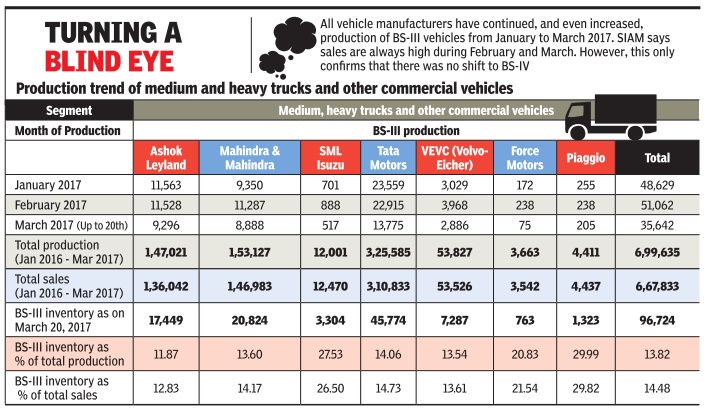

Most Didn't Scale Down Output Despite April 1 Deadline For BS-IV Switch: EPCA
The Environment Pollution Control Authority (EPCA) has found that most vehicle manufacturers didn't prepare for the April 1deadline for a nationwide rollout of BSIV norm by scaling down their production of BS-III vehicles.
An analysis by EPCA of BS-III vehicle inventories, which Society of Indian Automobile Manufacturers (SIAM) had submitted to the SC recently , reveals that many companies continued production of BS-III vehicles in large numbers between January and March 2017.
“All vehicle manufacturers have continued and even increased production of BS III vehicles in the last quarter. SIAM has explained this by saying that sales are always high from February to March. However, this only confirms that there was no shift to BS IV . Ashok Leyland, for example, produced 10,935 vehicles in January 2016 whereas it was 11,563 vehicles in January 2017,“ the analysis said. The inventory for heavy commercial vehicles as on March 20, 2017 is 96,724.This is far higher than SIAM's earlier submission to EPCA wherein it had claimed that 75,000 vehicles would remain to be sold on April 1, 2017.
Experts said the concern is more with heavy diesel vehicles because of their heavy pol lution potential. According to EPCA, there can be up to 80% reduction in particulate matter (PM) emissions from trucks if they move to BS-IV stage. “The commercial vehicle manufacturers will have 13.82% of the annual production in stock as of March 20, 2017. Almost 15% of their annual sales will be in stock as of March 20, 2017. Ashok Leyland, Mahindra, Tata and Eicher-Volvo will have 95% of the BS-III inventory ,“ the ana lysis revealed.
Production of BS-III cars had more of less tapered off in the last quarter. The BS-III inventory as on March 20, 2017 is about 16,198.
The three-wheeler sector, however, is far from meeting the deadline. “This sector shows a complete disregard for the shift to BS-IV stage. SIAM had submitted to EPCA that 45,000 vehicles would remain as of March 31, 2017. This included figures for Bajaj, which has the largest market share in the segment. Now, the estimates are that 40,048 threewheelers would remain in stock, which is 13% of the annual production,“ the analysis said.
The total stock of two-wheelers by March 20, 2017 is 6,71,305, which is roughly 4% of total production from January 2016 to March 20, 2017.
The stand-off on the rollout of BS IV norms started in October 2016 when EPCA had directed that vehicle manufacturers exhaust their stock of nonBS-IV vehicles before April 1, 2017.But when the SC-mandated authority called another meeting in early February 2017, SIAM said manufacturers were not ready to meet the EPCA deadline.
The ministry of road transport and highways in its 2015 notification talks about manufacturing only BS-IV compliant vehicles from April 1, 2017. It doesn't mention when registration of BS III vehicles is to be stopped.
Impact on two-wheeler industry
BS-III ban to shave Rs 600 crore off two-wheeler makers' margins, Apr 3, 2017: The Times of India
HIGHLIGHTS
The two-wheeler industry offered huge discounts on BS-III compliant models recently after the Supreme Court ban.
A Crisil report suggests the two-wheeler industry would have lost approximately Rs 600 crore due to the discount sales.
Supreme Court had banned sale of BS-III vehicles from April 1.
The two-wheeler industry would have lost Rs 600 crore due to the discount sales and incentives offered to meet the apex court ban on selling BS-III models+ from the new financial year, says a report.
The impact is comparatively low as many of the companies like Bajaj Auto, Yamaha and Eicher had already upgraded to BS-IV from January 2017, while market leader Hero MotoCorp, and the No. 2 Honda and also TVS Motors have upgraded most of their models before the ban set in, says a Crisil report on the impact on the Supreme Court ban. When the ruling came the two-wheeler industry had an inventory of 6,70,000 units of BS-III models, amounting to Rs 3,800 crore which is half of monthly sales of the industry. But 10-30 per cent discounts and freebies+ helped the dealers clear most of the stock in the last three days of March.
"Total discounts offered work out to be around Rs 600 crore, of which the two-wheeler makers would be sharing over 70 per cent of the incentives, taking a total hit of Rs 460- 480 crore, while the remaining losses would be absorbed by the dealers," says the Crisil report.
This will lead to a 150-200 bps erosion in the aggregate fourth-quarter Ebitda margin of listed players (Hero, Bajaj and TVS) in fiscal 2017, with the industry leader Hero taking a higher impact due to its large BS-III inventory.
Impact on Bajaj's profitability will be much lower due to its lower inventory and lower discounts offered considering the export option. Relative to annual revenues, this works out to 50 bps impact in fiscal 2017 Ebidta margins on Bajaj. As the Ebidta margins of listed two-wheeler players trended 40 bps higher than last fiscal on YTD basis, there is likely to be a 10 bps dip to 15.9 per cent in fiscal 2017.
On the positive side the wholesale deliveries for the industry will remain steady unlike the truck and bus makers, which are expected to fall due to the price hike on new models. This is also because the two-wheeler makers did not replenish channel inventory in the last three days of March, except in a few states like Punjab where 30 per cent of the sales were billed to dealers.
Channel inventory at end March was trending at 25 days' sales (lower by 5-10 days from annual average) and is expected to be replenished gradually over the next few months. "We, however, expect the gradual inventory build-up to be offset by slower retail sales momentum as much of the demand got pre-poned to March," says the report.
Meanwhile the report said carmakers are largely unscathed, while there will be a marginal hit on the three- wheeler makers. For car companies, with the BS-III inventory at just 16,000 units, the impact is marginal. On top of it, given the steep discounts offered in the last three days March, much of this stock is expected to have been cleared. For three-wheelers, since BS-III inventory could not be cleared due to limited number of permits, there will be a marginal impact for Piaggio and TVS while Bajaj will be unscathed as it had already transitioned to BS-IV.
BS VI
Bharat Stage norms
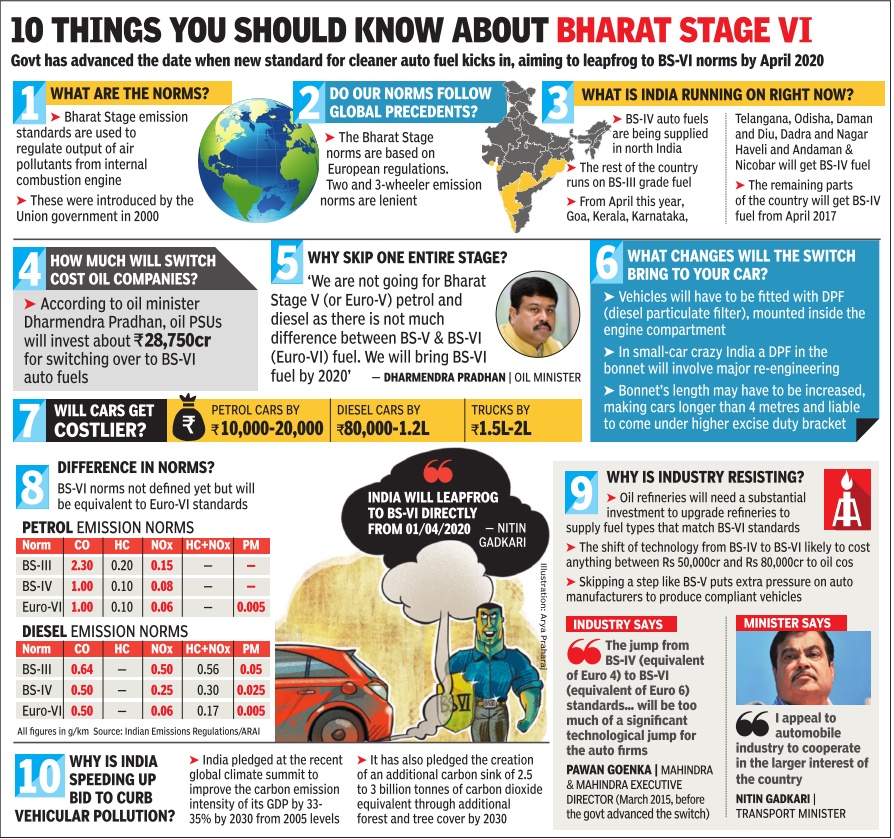
See graphic, 'What are Bharat Stage norms? The status as in Jan 2016.Preparations for Bharat Stage VI'
Car recalls

2012-16
The Times of India, Jun 05 2016
The Volkswagen Group will roll out its massive recall programme in India from July to fix a software following the global emissions scandal discovered in the US in September 2015. The German auto major had said in December 2015 that it would call back as many as 3.24 lakh cars from VW, Audi and Skoda brands. It will kick off the recall with 1.98 lakh cars in the VW brand. After that, 88,700 cars from Skoda and 36,500 cars from Audi across various models will be recalled. Volkswagen had ad mitted use of defeat device in 11 million diesel engine cars sold in the US, Europe and other global markets that allowed manipulation of emissions tests by changing the performance of the vehicles to improve results.
Most of the major models sold by the VW group will be covered in the recall exercise as the spiked machines carry 1.2-litre, 1.5-litre, 1.6-litre and 2-litre diesel engines. These are derivatives of the EA189 diesel engine family where the cheating software was installed globally . A source within the VW group said Polo, Vento, Jetta and Passat are among the vehicles from the VW stable that will be im pacted by the recall. For Audi, the models to be recalled include the A4 and A6 sedans and the Q3 and Q5 SUVs. The affected Skoda models include Fabia compact and Rapid, Laura and Superb se dans and the Yeti SUV .
“Starting from the second half of 2016, Volkswagen will recall 1.90 lakh cars and continue till 10 months,“ Volkswagen India head of marketing Kamal Basu said. “Since recall was done in the US to fix the emission software, the company decided to do the same in India too to stay updated with the changes made outside,“ he added, without giving details about the mod els covered in this round.
Sources in the group told TOI that Skoda and Audi recall would begin around the same time. Customers will be intimated regarding the exercise which the VW offi cial said was “purely voluntary in nature“.
The company was found to be using a cheating device in the US to mask higher emissions, which gradually erupted into a global scandal.
2015: The big Volkswagen recall
The Times of India, Dec 02 2015
Pankaj Doval & Dipak Dash
VW recalls 3.2L cars, may halt sale of diesel models
Embattled German auto major Volkswagen Group may halt the sale of a number of its diesel engine models in India across brands like VW , Audi and Skoda over the global diesel emissions cheating scandal that saw it recall 3.24 lakh cars on Tuesday, making it the biggest-ever such exercise. Weeks after a government testing agency saw various models of the group spewing higher levels of pollutants than lab results -similar to the results in the US where the scandal first broke out in September this year -the VW Group refused to admit to fixing an emission cheating software. But soon after a meeting with government officials on Tuesday afternoon, VW announced the “voluntary recall“.
Company sources indicated that the group will fall in line, although there was no official comment on the issue. Most of the major models sold by the VW group will be covered in the recall exercise as the spiked machines carry 1.2-litre, 1.5litre, 1.6-litre and 2-litre diesel engines. The engines are derivatives of the EA189 diesel engine family where the cheating software was installed globally to buck tough emission norms and achieve higher efficiencies.
For Audi, the models where the recall will be announced included the A4 and A6 sedans and the Q3 and Q5 SUVs.For Skoda, the affected models include Fabia com pact and Rapid, Laura and Superb sedans and the Yeti SUV . The cars impacted are those that have been sold between 2008 and till the end of November this year.These are approximately 198,500 cars from VW, 88,700 cars from Skoda and 36,500 cars from Audi across the various models.
An official source said that the group was “nearly made to admit guilt“ as the government presented it with the findings of Automotive Research Association of India (ARAI).
Components, automobiles
Imports
As in 2019

From: June 20, 2020: The Times of India
See graphic:
The import of automobile components by India, presumably as in 2019.
Crash tests/ safety ratings
2016: 5 models fail UK crash tests
The Times of India, May 18 2016
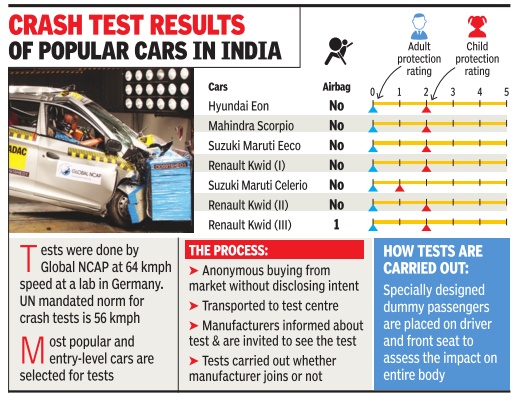
Dipak Dash
Five popular Indian cars failed the Global NCAP test. The ratings are based on the impact of the crash on the occupant, including on the driver and passenger's head, neck, chest and knees.
Over the three years, Global NCAP has tested 14 models and only two vehicles with airbags -Vokswagen Polo and Toyota Etios -have so far received four star rating for adult safety . Other models tested earlier included Maruti Swift, Datsun Go, Ford Figo, Tata Nano, Hyundai i10 and Maruti Alto.
The first edition of the tests drove the government to finally make crash-testing mandatory from next October although the bar has been set at 56 kmph instead of Global NCAP's 64 kmph. India has settled for the speed which is the norm set by the UN. A road transport and ghways ministry official highways ministry official said he has raised the issue that there is no point to conduct a crash test of a vehicle that doesn't have an airbag since it is bound to fail.
Responding to why the tests were conducted at 64kmph while the UN's regulatory norm is 56 kmph, Ward said nine NCAPs across Europe, Latin America and ASEAN followed the same norm.
The car firms concerned, however, refused to read much into the tests. While Maruti said its products are safe when looked at from the perspective of present-day norms, Hyundai said its cars meet norms set by Indian regulators. Renault India said it is geared up to meet any stricter standards, and Mahindra & Mahindra said its Scorpio failed the test as the non-airbag variant was tested.
2018: Brezza comes on top, Lodgy scores a zero
September 28, 2018: The Times of India
Maruti Suzuki’s SUV Vitara Brezza has got the second best safety rating by international vehicle safety watchdog, Global NCAP, which carried out the crash test recently. Renault’s Lodgy without airbag, which also underwent frontal crash test, scored zero star in rating.
Earlier in 2018, Tata Motors’ mini SUV Nexon had got a four-star rating for adult and three-star rating for child occupants and retained the top spot with the highest safety rating among 26 models that have undergone the crash test carried out by Global New Car Assessment Programme (GNCAP) between 2014 and 2018.
The latest results were announced at College for Traffic Management on Thursday. According to the results, Brezza got the fourstar rating for adult occupants and two stars for child occupants, while Lodgy got only two stars for child occupant protection. Renault has
claimed that all its products meet the regulations set by Automotive Research Association of India (ARAI).
GNCAP tested all the cars at 64 kmph, which is higher than India’s mandatory norm of 56 kmph. The safety rating of cars are made on a scale of zero to five based on the impact of frontal crash.
“The four-star result for Maruti Suzuki’s Vitara Brezza is really impressive.... It shows the positive effects of India’s new crash test standards... We are getting close now to seeing India’s first five-star car and we are hopeful of getting it by this year end,” David Ward, GNCAP secretary general said.
While Ward said poor rating for Renault Lodgy is disappointing, the car maker said, “Our products are ARAI certified, which is the current mandate in India. As India is gradually moving towards international safety and emission norms by including more robust regulations, Renault will be ready for the upcoming safety regulations and BS VI norms.”
Diesel vehicles
Restrictions on
The Times of India, Aug 13 2015
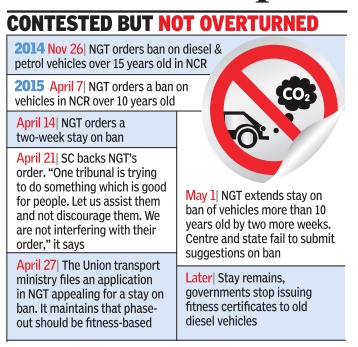
NGT cited apex court order upholding ban
The ban on diesel vehicles over 10 years old in NCR stays, as the National Green Tribunal declined to change its order. It said Delhi government and states that are part of NCR may decide whether to continue to take action against old vehicles. Additional solicitor general Pinky Anand, appearing for the road transport ministry , sought that the order be modified “in public interest“, saying if truckers went on strike -as they were mulling -it would impact supply of essentials to the capital. The government shouldn't be expected to challan them as long as the matter was pending, she urged.
The bench headed by NGT chair Justice Swatanter Kumar responded, “We decline to vary our earlier order. Till disposal of application... it's for the state to challan diesel vehicles or not to prevent... non-supply of essential articles to Delhi.“ ASG Anand had ap proached NGT appeal ing for a modification to NGT's earlier order: “In public interest, at least the state may not be held responsible for challaning of diesel vehicles during the pendency of the application.“ Anand said, “If the transport associations or truckers go on strike because of authorities not issuing them fitness certificates, common people will suffer. That is why we are appealing that the order be withdrawn or modified for the time being,“ Anand said.
The All India Motor Transport Congress in a meeting on August 10 had decided to abandon their commercial vehicles more than 10 years old at the entry point of Delhi at Ghaziabad, Gurgaon, Badarpur and Noida. The purpose was to protest against the nonissuance of re-registration and fitness certificates of diesel vehicles that are over 10 years old by the state govern ments of Delhi, Uttar Pradesh and Haryana, in response to NGT's order of banning these old vehicles.
The tribunal also said the ban on the vehicles over a decade old has been upheld by the Supreme Court and the tribunal cannot go against the apex court's decision.
Anand told the bench that truck operators were mulling a strike and protesting against governments of Delhi, Haryana and UP for not is suing fitness certificates to diesel vehicles more than 10 years old. A strike could mean disruption of the supply of essential services to the city.
In the weeks following NGT's order to ban, Delhi traffic police had impounded about 2,000 polluting diesel vehicles. These were released later on. No more vehicles have been impounded since.
The Centre had moved NGT seeking a stay on the ban order. The ministry has also sought a time of six months to suggest measures to address air pollution. In its application, the ministry had claimed only 7% of the vehicles in the capital are over 10 years old and that any “stringent measure of ad-hoc nature to ban vehicles on the basis of age will not provide any holistic solution to the pollution problem.“
It subsequently submitted several IIT Delhi studies and documents to argue that the transport sector is not responsible for the majority of emissions.
Pankaj Doval, Diesel cars’ mkt share dips to 23% from 50%, January 3, 2018: The Times of India

From: Pankaj Doval, Diesel cars’ mkt share dips to 23% from 50%, January 3, 2018: The Times of India
5-Yr Trend Mirrors Closing Fuel Price Gap
Call it a fear psychosis towards diesel cars, or pure economics. But the share of diesel in hatchbacks and sedans has fallen to under a quarter, which means that more than three cars out of every four sold are now run on petrol. The narrowing gap between petrol and diesel fuel prices has been one of the critical factors behind the trend, which should sound like music to environmentalists and green lobbies.
The numbers are even more encouraging as the trend comes at a time when pollution figures have been at alarming levels across many Indian cities and there have been calls for controlling vehicular emissions, especially from diesel ones.
According to numbers accessed by TOI, the share of diesel in car sales (hatchbacks and sedans, excluding SUVs) has fallen to 23%, coming down from a high of nearly 50% in 2012-13. The trend is only going to get stronger, say company executives who are now preparing for a life beyond diesel as the government pushes for cleaner technologies where the current focus is on electric drivetrains.
The only challenge to the trend, however, remains the rising share of SUVs in the country. Diesel is traditionally the preferred choice in SUVs, though the mindset towards petrol is also finding some strength here. Take for example the Creta SUV where more than 30% of sales are coming from petrol version.
The trend has been stark for some of the companies when it comes to small cars and sedans. For example, Honda Cars India has seen the share of diesel in overall sales shrink from 67% in 2013-14 to just a quarter at the end of 2016-17. Honda City sedan, which used to see 60% of sales coming from diesel in 2014, now gets only 20% of its volumes from the fuel.
The same is the case for some of the models of Maruti Suzuki, the country’s largest carmaker. For example, diesel variant now accounts for 30% of sales of the Ciaz sedan against 60% just some time back. However, diesel still remains strong for the company as some of its models such as Brezza mini SUV do not have a petrol variant.
Maruti chairman R C Bhargava says that the trend is only going to get stronger, at least in the passenger cars segment. “I don’t see a big play (for diesel). The market does not like diesel. I expect its share to come down.”
Diesel cars, while giving higher fuel efficiency, are also expensive to maintain when compared to petrol versions. The higher maintenance comes at the top of an already expensive acquisition cost — diesel variants are priced higher than their petrol versions, by at least Rs 1lakh.
With the difference between petrol and diesel fuel narrowing down, many people now prefer to opt for petrol versions. Against a gap of Rs 27 around the middle of 2012, the difference in the retail price of petrol and diesel fuel has narrowed down to only Rs 10 now. “Diesel is losing ground now, and the shift is quite pronounced,” says Rakesh Srivastava, director (sales & marketing) at Hyundai India.
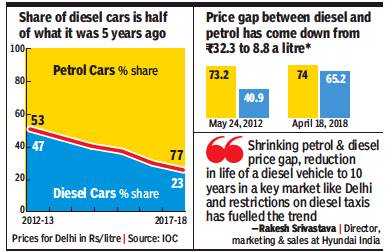
From: Pankaj Doval, Just one in every four cars sold today is a diesel vehicle, April 20, 2018: The Times of India
Five years ago, one out of every two cars sold in the country was a diesel vehicle. Today, that figure has halved to just one in four cars.
The fall is not confined to sedans and compact cars, it has also impacted the SUV category, which has traditionally been a strong diesel votary. The share of petrol vehicles in SUV sales has grown nearly five-fold from 3% in 2012-13 to 16% at the end of 2017-18.
The narrowing price gap between petrol and diesel has been feeding the trend, as have numerous regulatory and legal actions – larger diesel engines (over 2,000cc) were banned in Delhi-NCR for around eight months in 2016, and have a legally permissible life of only 10 years in the national capital against 15 years for petrol.
A similar shorter life for diesel vehicles – which have higher particulate matter (PM) and nitrogen oxide (NOx) emissions — is being contemplated by many other state governments across the country on concern over rising pollution, prompting many buyers to shift their priorities towards petrol.
Taxis in many cities are not allowed in diesel, but only in petrol or petrol/CNG.
Demand for diesel cars set to dip further on higher price
According to numbers provided by industry body Siam, the share of diesel in car sales has come down to 23% at the end of 2017-18 against a high of 47% in 2012-13 (it was 27% in 2016-17). In SUVs, the share of diesel is now 84% against 97% in 2012-13.
The demand crunch for diesel vehicles is only going to get stronger as retail prices of the vehicles — already higher by around Rs 1-1.5 lakh against petrol counterparts — could move up sharply when the stricter BS-6 emission norms kick off from 2020. The upgradation will result in major modifications and upgrades to diesel engines, and companies say that this will further increase their prices against petrol versions.
Carmakers are now trying to align their product strategies in line with the trend. For example, Toyota – which gets most of its sales from diesel engine cars such as the Innova and Fortuner – has decided to opt for only a petrol engine for its soon-to-be-launched sedan, Yaris. The car, that will compete with models such as Honda’s City and Hyundai’s Verna, will sport a 1.5-litre petrol engine. “Petrol is where we see a strong demand. Thus, we decided against having a diesel engine on the Yaris for now,” Toyota Kirloskar Deputy MD (Marketing & Sales) N Raja told TOI.
Luxury makers such as Mercedes, Jaguar Land Rover, and BMW have also been adding petrol variants across their product line-up against previous offerings which mostly comprised diesel cars.
Mahindra and Mahindra, the company with the strongest sales connect with diesel, also opted for a petrol variant when it introduced its mini utility vehicle KUV100 that comes with a 1,200cc petrol heart. Maruti chairman RC Bhargava has said that there will be pressure on diesel sales in coming times. “I don’t see a big play (for diesel). The market does not like diesel. I expect its share to come down,” he said recently when asked to comment on the trend.
Durability of cars
Average age of cars on road
Transport min says ban unfair on owners
Dipak Dash The Times of India Dec 03 2014
The findings of a study by IIT (Delhi) for UN Environment Programme showed that on average, less than one percent cars which are over 15 years old are plying on Delhi roads. The findings were same for two-wheelers. The findings were based on vehicles reporting at fuel stations and pollution checking centres. While the sample size for cars was 2,231, it was 1,570 in the case of two-wheelers. The survey found that the average age of cars on road was 4.4 years and the average age of two-wheelers was 4.7 years.
The study also covered two other cities Visakhapatnam and Rajkot and the findings were not much different.
Referring to a study conducted by central roads research institute (CRRI) in 2007, the report has mentioned how the vehicle registration date in Indian cities is an overestimation of the actual number of vehicles plying. This is because private vehicle owners pay a life time tax on the purchase of the vehicle and don't have to register their vehicle annually .
Exports
Mexico: 2015-16
Udit Mukherji | TNN | Sep 5, 2016
Mexico is top destination for India’s automobile exports
Mexico has emerged as the top destination for India's automobile exports, making a compelling case for the Indian engineering exporters to further push forward in the growing south American markets, according to EEPC India.
The EEPC India, which would be organising India Pavilion at Expo National Ferretera 2016 to be held in Guadalajara (Mexico) later this week, came up with an analysis which found that the neighbouring US occupied the highest slot for outward shipments of the automobile components, according to April-July data analysis by the engineering exports body EEPC India. JK Tyres to up exports with Mexico plant Of the total automobile exports of $2.78 billion between April and July this fiscal, as much as $501 million were shipped to Mexico, followed by Nepal at $157 million and UK at $130 million.
These exports to Mexico saw a phenomenal rise of 110 per cent while for Nepal, the increase was even more impressive at 120 per cent for the period under review. For the UK exports, the rise was 22 per cent.
"Auto exports to Mexico were not constrained by a vast distance that our shipments have to cover. Mexico has come to account for as much as 18 per cent of India's total automobile exports. This is significant," chairman of the apex body of the engineering exporters, T S Bhasin said. While total engineering exports for the April-July 2016 period slipped by 5.82 per cent to $20.27 billion from $21.52 billion in the same period last fiscal, the total automobile exports increased by four per cent to $2.78 billion for the period under review.
Even though shipments fell to destinations like Sri Lanka, South Africa and Bangladesh , they continue to remain important destinations for the auto exports accounting for $158 million, $151 million and Bangladesh $102 million respectively, the EEPC India analysis showed. For the automobile components, the US remained the top destination, followed by Turkey with shipments at $345 million and $116 million. These exports to the US increased by over eight per cent and Turkey by 1.30 per cent. Total global exports of Indian automobile components aggregated to $1.48 billion during April-July 2016, growing by 4.54 per cent on annualized basis.
This government is really doing an excellent job. The credit should go to Shri Narendra Modi, who is incessantly putting up hard work--he works 16-18 hours a day and hardly taken a day off from dutie... Read More
Automobiles and automobile components form a major part of India's overall engineering exports and are among the few sectors showing positive trend this fiscal. A large number of Indian IT and pharmaceutical firms including TCS, Infosys, Wipro, Sun Pharma and Dr Reddy's Labs have set up their facilities in Mexico for their stronger presence in Latin America, Bhasin added.
2017, H1: Maruti tops
Maruti is top passenger car exporter from India, October 22, 2017: The Hindu
In the first half of fiscal, MSI shipped 57,300 units followed by Volkswagen India with 50,410 vehicles
Maruti Suzuki India has become the largest passenger cars exporter from India in the first half of the ongoing fiscal, dethroning Hyundai Motor India Ltd. which has now been pushed to the fourth spot behind Volkswagen and General Motors.
In the April-September period this fiscal, Maruti Suzuki India (MSI) exported 57,300 units of passenger cars, a rise of 6% from the 54,008 units in the year-earlier period, according to the latest data by Society of Indian Automobile Manufacturers (SIAM).
The long-running number one exporter, Hyundai Motor India Ltd. (HMIL) saw a sharp decline of 29.25% to 44,585 units compared with the 63,014 units in the year-earlier period.
Hyundai slips
The company is now behind Volkswagen and General Motors India in terms of export of passenger cars from India.
During the first half of the fiscal, Volkswagen India exported 50,410 units, recording a growth of 16.92%.
It is now the second-largest exporter of passenger cars from India behind MSI.
Last year, it had exported 43,114 units during the same period. Interestingly, General Motors (GM), which had, on May 18 this year, decided to stop selling its vehicles in India after struggling for more than two decades to make a mark, is now the third-biggest exporter of passenger cars from the country.
GM posts growth
In the first half of the fiscal, GM exported 45,222 units as against 30,613 units in the year-earlier period, a growth of 47.72%.
The company exports vehicles from its manufacturing plant at Talegaon in Maharashtra.
It had sold its first plant at Halol in Gujarat to MG Motor India, an arm of China’s SAIC.
Another U.S. auto major, Ford, also posted impressive growth in exports of passenger cars from India during the period.
The company’s overseas shipments stood at 42,412 units as against 31,467 units in the same period last fiscal, rising 34.78%.
Nissan Motor India, which was the third-biggest exporter last year, saw its overseas shipments during the first half of the fiscal decline by 37.11% to 30,872 units, from 49,091 units in the same period last fiscal.
Nissan now occupies the sixth spot.
FASTags
Compulsory from Dec 2017
Dipak Dash, FASTag must for all new four-wheelers from Dec 1, November 3, 2017: The Times of India
All new four-wheelers will need to get FASTags fixed on their front windscreens before they come out of factories or dealer showrooms from December 1, the transport ministry notified.
In the case of vehicles, which have drive-away-chasis including trucks and buses, the FASTags will be installed by owners before their registration. This means the onus of fixing the smart tags on four-wheelers will be on manufacturers and dealers. Sources said the transport ministry should have made the manufacturers responsible for installing FASTags for easier and quicker implementation.
FASTags use radio frequency identification technology and allow vehicles to pass through toll plazas without waiting in the queue as the payment is made electronically .
TOI on May 4 had first reported the government move to introduce this regime rather than vehicle owners buying and installing the tags. The report had also highlighted how nearly 74 lakh RFID tags installed in cars had become dud and this had prompted the ministry to start the new initiative to increase number of vehicles with FASTags.
The government is looking at increasing the penetration of FASTags to end congestion at toll plazas and to ensure no leakage of toll revenue. Till Thursday about 7.5 lakh FASTags were sold across the country .
India’s rank among automobile manufacturers
2000-2015: India vs. China, others
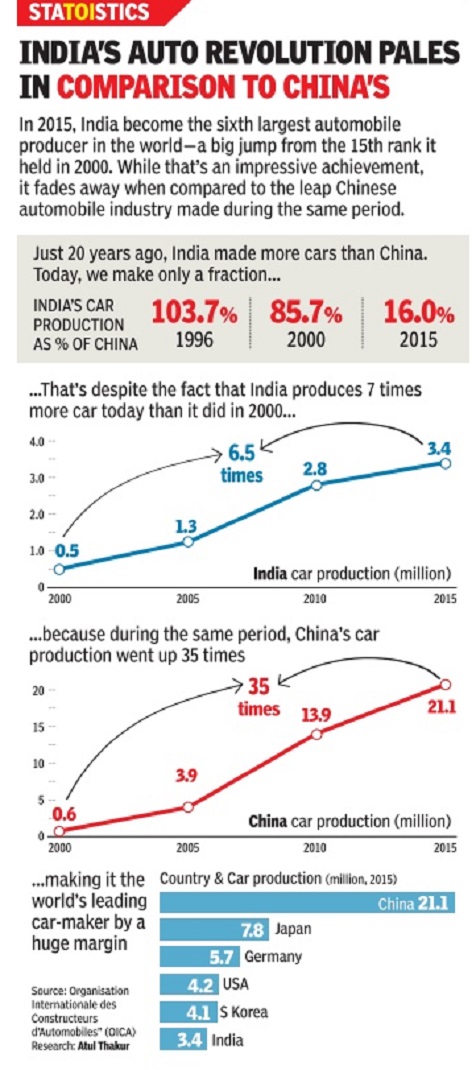
The Times of India
See graphic: 'India vis-à-vis China automobile production, 2000-2015'
2008: India 8th automaker in the world
From the archives of The Times of India: 2008 ‘India figures in top 15 automakers’
New Delhi: With a burgeoning auto industry to boast of, India has made it to the top 15 automakers of the world and occupies the fourth position in the leading developing countries' category of motor vehicle manufacturers, a UNIDO report has said.
According to the UNIDO International Yearbook of Industrial Statistics 2008, India ranks 12th in the list of world's top 15 automakers, which is led by Japan followed by the US and Germany. Other countries making it to list are Mexico, France, Korea, UK, Canada, Spain, Iran, Sweden, Brazil, Italy and Indonesia.
In the leading developing countries category, India ranks fourth. The list is topped by Mexico, followed by Korea, Iran. Brazil holds the fifth position followed by Indonesia, Turkey, Argentina, Thailand, Singapore, China, China (Taiwan Province), Malaysia, UAE and Columbia.
India also figures among the world's top 15 producers of chemicals and chemical products, electrical machinery and apparatus, basic metals, coke, refined petroleum products, nuclear fuel, non-metallic mineral products (glass and glass products, cement, lime and plaster, ceramic products), machinery and equipment, leather, leather products and footwear and textiles, the report said.
The country ranks fifth among the top 15 textile producers in the world. China has captured the top slot followed by the US, Italy, Japan, Mexico, Thailand, Indonesia, Pakistan, Germany, Korea, UK, Brazil, Turkey and Bangladesh.
The Yearbook is the 14th issue of UNIDO's annual publication and is based on 2006 data. It follows the International Standard for Industrial Classification that categorizes the automobile sector as manufacture of motor vehicles, bodies (coachwork) for motor vehicles, trailers and semi-trailers and manufacture of parts and accessories of motor vehicles and their engines.
2016/ production of passenger cars, India and the world
See graphic
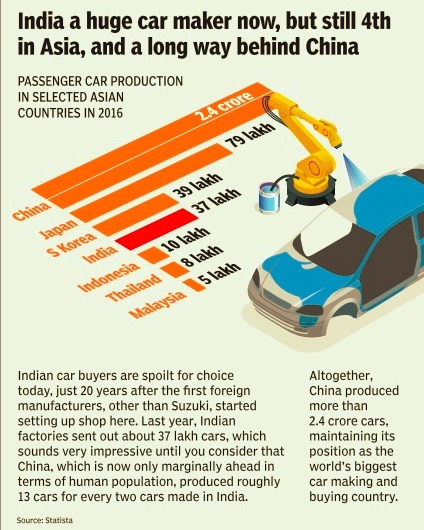
India’s rank in automobile sales
2018, Feb: no. 4 in world
Nandini Sengupta, India pips Germany to be No. 4 car mkt, April 13, 2018: The Times of India
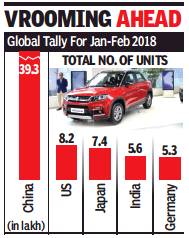
From: Nandini Sengupta, India pips Germany to be No. 4 car mkt, April 13, 2018: The Times of India
Top-gear growth in sales of cars and SUVs has led to India becoming the fourthlargest passenger vehicle (PV) market globally for the first time ever, unseating Germany, in January and February 2018. With sales of 5,60,806 units in the first two months of calendar 2018, India overtook Germany’s tally of 5,31,100 units. As a result, India is now behind China, US and Japan in the global pecking order with Germany in the fifth position, followed by Brazil and France.
According to a study by SIAM, while China continued to dominate with sales of nearly 4 million units in January and February 2018, US at number two with 8,18,882 units and Japan at number 3 with 7,41,385 units saw significant contraction.
Germany’s slip was predicted by its automotive industry body VDA earlier. According to VDA, Germany is predicted to see a 2% contraction in its 3.4-million unit sales in 2018, while India is expected to see a 10% increase in the same period.
Accordingly, India should hit around 3.6 million units in 2018 sales, exceeding Germany’s tally for the full calendar as well. India is also the only market in the top four that is on the growth track and is predicted to see a sharp increase in sales. Others like the US and Japan are likely to be flat or negative, and even China was flat in the first two months of 2018. The VDA prediction puts China’s 2018 tally at 25 million units, followed by the US at around 17 million and Japan at 4.3 million. The EU’s cumulative numbers are expected to be 15.6 million units.
Domestic auto experts concur. “The PV market is expected to witness 8-10% growth in FY18, helped by new model launches and favourable macroeconomic environment, with GDP growth rate expected to improve in the second half of FY18, and recovery in rural income,” said EY partner and automotive sector leader Rakesh Batra.
Inspection and certification
2016: 68% of vehicles fail test, centre vandalised
The Times of India, Jun 17 2016
Dipak Dash
68% of vehicles fail test in Nashik, centre vandalised
In a glaring example of how changes made to bring transparency do not go down well with private players, the central government's first automatic vehicle inspection and certification (I&C) centre in Nashik was vandalised in May after 68% of the vehicles failed the IT-based tests conducted between October 2015 and April 2016. Data available with TOI show the failure percentage was as high as 94% in November, 2015. The vehicles failed both in equipment tests as also visual tests. The centre was launched October 2015 and the government has an ambitious plan of setting up dozens of such automated I&C centres to bring in a transparent regime for vehicle-testing.
The centre is equipped to carry out a range of checks including for pollution, speedometers, brakes, suspension, wheel toe-in and toe-out, headlight aligner and under-body inspection using machines.
“We held a meeting with the top officials of the Maharashtra government. They have assured us that law and order will be maintained for making this centre operational,“ a road transport ministry official said. TOI has learnt that the damage caused to the centre is estimated to be around Rs 10 lakh.
Former director general of Automotive Research Association of India (ARAI) Balraj Bhanot said there have been hardly any instances of vehicles failing such tests in the past as everything was done manually .“Moreover, less than 40% commercial vehicles report for testing and this serves the purpose of enforcement agencies. The more the number of untested vehicles, the more is the scope for corruption,“ he said.
Sources also said that the operator of the Nashik centre has sought government help to ensure agents and touts are not allowed to come close to the campus.
“The government should focus more on strengthening this system rather than going for retiring of old vehicles, which suits the automobile industry ,“ said S P Singh of IFTRT, a think tank on transport issues.
Jeeps
Rahul Noronha , Hindustani motors “India Today” 5/6/2017
The quintessential jeep was, and continues to be, a lifestyle thing in Bhopal. Not always connected to the brand, a Bhopali 'jeep' could be a Ford GPW, a low bonnet Willys MB, a Willys M606, an M38 A1 or even a later Mahindra equipped with jholas-one attached at the back and a smaller one near the dashboard. Bhopali jeeps are often unpainted, or only have a coat of primer, and continue to find patrons, with owners never having to think about resale values.
Arriving in Bhopal as the wheels of choice for Nawab Hamidullah Khan, the early jeeps were mainly used in shikaar. Wealthy farmers also used them to ferry themselves to and from their farms. The jhola at the back carried anything from dead game to beaters to gunny bags, while the smaller jhola mostly held chaalia (the Bhopali word for supari) and paan.
"With shikaar gone and farm holdings shrinking, the jeep lost some of its importance, but continues to be a utility thing here," says Bhopal-based automobile enthusiast and restorer Rajan Deb. "In Bhopal, there are those who use the jeep for work and then there are those who collect original Fords and Willys," he adds.
The jeeps have survived the decades thanks mainly due to 'doctors'-mechanics who keep them going using jugaad. "The work is not what it used to be but I am happy with what I have done," says Mohammed Zameer, who uses the takhallus 'Nirale' and is one of the better known jeep mechanics in Bhopal. Nirale's grandfather opened a garage in 1946. Nirale apprenticed with him before starting his own shop in 1967. "You learnt everything on the job; there was no option for training or getting a degree," he says, adding that the work is still commercially viable. "Bhopali jeeps have great demand. One of my old jeeps is in Canada with a collector," he says. Prices for original Ford GPWs and Willys MBs range from Rs 10 lakh to Rs 15 lakh.
In the Lal Masjid quarter of Bhopal, more than a dozen garages thrive. Pyare Bhai, one of the owners, says that modern SUVs have taken a toll, but the jeep craze remains. "There are people who spend the entire day with us, seeing how jeeps are repaired," he says. Expert mechanics have come from the ranks of jeep owners as well. One of the sons of a family of Pathans living at Khandera-Pudhiya-was referred to as an 'honorary engineer'. Many jeeps bore a 'designed by engineer Pudhiya' message on the registration plates. And today, jeeps are no longer an all-male preserve. "Driving a jeep is all about slowing down in life, to appreciate everything that you could miss in a fast car," says Sonia Rashid, who is married into the erstwhile Bhopal royal family and is the proud owner of a Willys jeep.
Just as Nirale is about to close his garage for the day, a customer walks in and admires a parked Ford GPW. Inquiring about the price, he is taken aback at the quote. "Why is it so expensive?" he asks. "Nut, nut par Ford likha hai, miyan (Everything is original-even the nuts and bolts have the Ford 'F' emblazoned on them)," replies Nirale.
Luxury segment
Sales: 2015- 2018, June
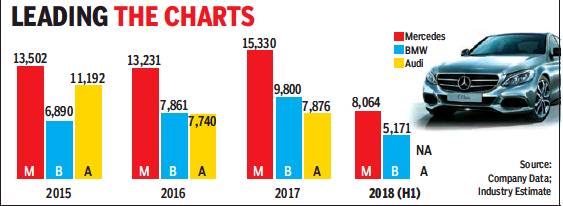
From: Pankaj Doval, Merc races past BMW in Jan-Jul, July 7, 2018: The Times of India
See graphic:
The sales of the Top 3 Luxury cars in India, 2015- 2018, June
2016: Mercedes Benz remains first
Pankaj Doval, Audi loses number 2 spot to BMW , May 3, 2017: The Times of India
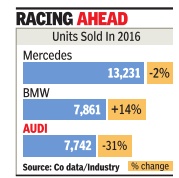
Audi's sales in India crashed by over 30% in 2016 as the company lost its second ranking in the luxury market to fellow German compatriot BMW , which staged a revival on a 14% growth. Mercedes Benz, however, maintained its top billing in the category.
Slide for Audi continued in the first quarter (JanuaryMarch) of this year as numbers slipped by 22% year-on-year. Its volumes fell to 2,131units as against 2,738 units in the same period last year, sources told.
When contacted, Rahil Ansari, head of Audi in India, refused to confirm the numbers, but conceded that 2016 “was a challenging year“.
“Although 2016 was a chal lenging year in general for the industry , we utilized this period to consolidate our business in India,“ Ansari said, adding that, “We do not discuss our sales data in media. However, we can confirm that we had a good start to the year (2017). We are ahead of our planned targets and expect to close the year with double-digit growth.“
Ansari took charge of Audi's Indian unit in February 2016, succeeding Joe King, who was moved back to the company's headquarters in Germany .“We want to be at the top spot as we belong there. We do not have to do it overnight but in a sustainable manner -when we reach the top, we will stay there,“ Ansari said. Sources said the slide in Audi's volumes was being seen as “worrisome“ by the company's management, considering that it was top luxury carmaker in India just two years back.
BMW, on the other hand, has been making a slow progress towards getting its mojo back in India. Once a strong force, the company had lost its drive over the past few ye ars. It made a comeback in 2016 -although on a small base -giving it a reason to cheer.
BMW's revival was led by Frank Schloeder, who was the acting president of the India operations last year. “2016 has not been an easy year for the automotive industry and that applies equally to BMW Group India... Despite a challenging business environment, BMW Group India has increased sales and market share,“ Schloeder, now posted out of India, said on the company's performance.
Ansari said India is a “small but strategic market“. “There are short-term constraints like high taxes and duties but the GST regime seems to offer a simpler approach with fewer layers, which will probably make easier to do business.“
2016-18: Luxury car sales at record high
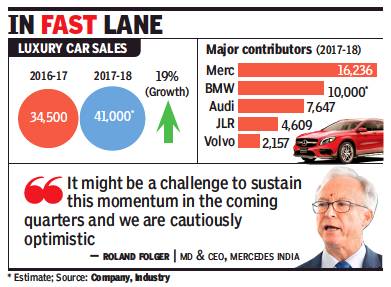
From: Pankaj Doval, April 7, 2018: The Times of India
See also:
The sales of the Luxury cars in India, 2016-18
Premium compact segment
Nov, Dec 2015: Baleno vs. i20
The Times of India, January 19, 2016
Pankaj Doval
Baleno No. 1 premium compact, beats i20
The battle between Maruti Suzuki and rival Hyundai is getting intense.Maruti's premium compact `Baleno', within months of launch from a new retail format Nexa, has overtaken Hyundai's best-seller `Elite i20'.The new Baleno is one of Maruti's most ambitious products and is the mainstay for Nexa channel at present, which is aimed at premium and upmarket customers.
Maruti Suzuki sold 10,572 Baleno in December compared to 10,379 Elite i20 by Hyundai, numbers released by industry body Siam showed. In November, Maruti sold 9,074 Baleno as against 10,074 Elite i20 by Hyundai.
Maruti's surge in the category comes at a time when it is set to challenge the Korean ri val in the SUV category as well. While Hyundai has been going strong with newly-launched `Creta', Maruti will un veil `Vitara Brezza' at the Delhi Auto Expo next month. It plans to commercially launch the SUV around March.
The Baleno -which carries a 1.2-litre petrol engine and a 1.3-litre diesel variant with key safety features such as dual air bags and ABS as standard -was launched by Maruti on October 26 with an aggressive entry price of Rs 4.99 lakh (ex-showroom Delhi) for the entry petrol variant (this went up to Rs 5.11 lakh after a price hike earlier this month). The base diesel variant costs Rs 6.21 lakh.The Elite i20's base petrol variant costs Rs 5.36 lakh, while the diesel version comes for Rs 6.47 lakh.
When contacted, Maruti officials said the Baleno now commands a waiting period.“The response has been strong, and we expect that the demand will remain robust in the coming months as well,“ said Partho Banerjee, senior VP at the company , who heads the Nexa channel.
Projects, company-wise
2005-2017: Changing preferences
Nandini Sengupta|Premium cars eat into entry-level pie|Jul 21 2017 : The Times of India (Delhi)
Cheap and cheerful no longer works on Indian roads. Desi car buyers' fascination with SUVs and automatic transmission has had an impact on the bottom end of the pyramid in Motown. The entry-level segment -comprising cars priced at less than Rs 5 lakh -has shrunk by nearly 50% in the last 12 years. According to SIAM data, the entry segment -which used to be 50.5% of the passenger vehicle market in 2005 -is down to 27.5% in FY17. The Rs 8-lakh and above segments, on the other hand, have grown from 19% to 26.5% in the same period even as the bulk of the market has shifted to the midsized segment in the Rs 5-8 lakh range. Given that a recent BCG study says the ` Aspirer, Affluent & Elite' segments in India's middle class -with annual income of Rs 5 lakh and above Source: Siam & Edelweiss Resea have collectively jumped from 13% in 2005 to 24% in FY16 and is expected to hit 36% by 2025, this premiumisation trend will continue say marketers.
Car marketers say one of the big reasons why the entry segment is shrinking is the lack of best-seller launches.
Although Alto is still the hig hest selling model in India, clocking around 20,000 units on average, it's a17-year-old brand.
A number of competitors have been phased out. Among the re cent entry-level models in the market, only Renault Kwid is clocking substantial numbers.
“The trouble is this seg ment is very focused on after sales service, so it is very diffi cult to crack this market witho ut a distribution network back up,“ said a senior marketer with one of the top mass-mar ket car companies. “Only Ma ruti, Hyundai, M&M and Tata Motors can crack the entry-le vel game. Newcomers will find it impossible.“
Said Rakesh Srivastava, se nior VP (sales & marketing), Hyundai Motor India, “The entry-level car buyer is highly price-sensitive but not willing to be identified as buying the cheapest in the market. This presents a challenge to auto . makers of working out a subRs 3 lakh product which is aspi, rational and meets current and future emission and safety re. quirements. Hyundai is cons cious of this demand and would love to introduce a product in this segment.“
Bajaj and Renault-Nissan
Bajaj’s small car with Renault-Nissan Alliance, unviable
The Times of India, July 16, 2011
Bajaj Auto’s ultra low-cost car plans with Renault-Nissan Alliance hit a new low as the company’s MD Rajiv Bajaj termed the project “unviable”, though the company later clarified that the troubled project was on.
Bajaj, speaking to reporters after announcing the company’s quarterly results, was quoted as saying by a news wire, “We don’t intend to get into the low-margin (passenger car) business.” He also told the news conference that from 2007 to 2009, “we had an initial plan with Renault and Nissan to develop a low-cost small car which would be like the Nano.” But sometime in November 2009, Bajaj informed Carlos Ghosn, chief executive of both Nissan and Renault, that the minicar project was “unviable”, to which Ghosn agreed, the agency reported. However,just as the statement by the Indian partner created ripples, the company issued a clarification, saying the project was still intact. “We would like to clarify the Bajaj-Renault-Nissan project is very much on,” S Ravi Kumar, Bajaj Auto’s senior V-P for business development, told another news wire in an emailed statement.
“The new four-wheeler platform, which will have commercial and passenger applications, will be showcased to Renault-Nissan in January 2012… Bajaj Auto will remain in the commercial space of the business while Renault-Nissan, if they decide to go ahead with the project, will be responsible for the personal transportation application,” he said. Bajaj and his executives did not respond to calls and text messages sent by TOI. A spokesperson for Renault refused to comment.
The conflicting statements, within hours of each other, however, did not come as a surprise as the partners have been having differences right from the time they came together. Conflicting statements, and doubts, over the viability of the project have been expressed by the partners from time to time. Things came to a boil in May when Renault India chief Marc Nassif said that the French auto major might pull out of the project if the car being developed and manufactured by Bajaj did not meet the alliance’s expectations.
Nassif followed this up in June by saying that Renault could even go solo on the project as “creating new ideas is in the DNA” of the company. This probably would have prompted Bajaj to go public with his statement on the split.
The ambitious project has been slow to take off since the very beginning. Delays, differences and constant bickering saw the partners often caught on the wrong foot in how they perceived the way forward for the development of the car. The troubles were very much visible after the partners never agreed to sign a joint venture despite the grandiose nature of the project.
HANGING IN BALANCE
2008
Bajaj does a one-up and unveils the prototype two days before the unveiling of the Tata Nano Carlos Ghosn-led Renault and Nissan join the ultra low-cost project, fix 2010 as the timeline for the model’s launch
2009
Differences surface between the partners. Colin Dodge, the global V-P for Nissan, says it is turning out to be a “very difficult’’ project Later in the year, Ghosn and Rajiv Bajaj meet on the sidelines of the World Economic Forum and try to sort out the differences. Ghosn says engineering, design and manufacturing expertise will come from Bajaj and Renault-Nissan will handle marketing and distribution
2010
Bajaj officials say early in the year that the partners are “aligned to the project and to the agreed objectives” and the “broad contours” had been agreed to Partners bury differences and sign an MoU.
2011
Tired of the slow progress and rising differences, Renault sounds non-committal to the project, saying it may pull out if the car developed by Bajaj does not meet expectations Rajiv Bajaj says he has informed Ghosn that the project is “unviable”.
Quadricycles
The Times of India, Jun 29 2015
Nandini Sen Gupta
Crash test must for quadricycles: Gauhati HC
In an interesting twist to the quadricycle saga, the Gauhati high court has in an interim order directed the central government not to permit auto manufacturers to release and sell small fourwheelers with a mass of up to 1,500kg and quadricycles without putting them to crash-test and emission test. The order says that since the quadricycle is “also a motor vehicle coming within the definition of M1 category,“ the emission norms applicable to the M1 category should have been made applicable to it and not the norms relating to two-wheelers and three-wheelers. The order is important because the quadricycle's crash and emission norms have been a bone of contention in the au to industry. The M1 category comprises passenger vehicles with not more than eight seats in addition to the driver's seat whereas N1 covers goods vehicles having a maximum mass of 3.5 tonnes.
Quadricycles are lightweight four-wheel vehicles meant for intra-city travel. Since the government notified this new category of vehicles on February 19, 2014, several high courts across the country have issued stay orders on their introduction which is why these vehicles have not yet hit the roads in India. However, in March 2015, the Supreme Court transferred to it self several petitions related to the launch of quadricycles and also extended a stay imposed on the orders of several high courts, including those of Delhi, Karnataka and Andhra Pradesh. Its final decision is still awaited.
The Gauhati high court order, delivered by Chief Justice (acting) K Sreedhar Rao and Justice PK Saikia, not only raises the safety and emission requirements for quadricycles but also covers all four-wheeler vehicles-both passenger and goods -with a mass up to 1,500kg. “It is the contention of the petitioners that the small passenger cars produced by the manufacturers in India do not conform to the safety standards,“ said the order.Referring to the European New Car Assessment Programme (ENCAP) test con ducted on Indian vehicles late last year, the order said: “The requirement of air bags and the sturdy frontal body are said to be primary conditions for safety of the driver and other inmates in the vehicle. However, in the test conducted by the ENCAP in November 2014, it is said that all small cars -four-wheelers in particular -of the M1 and N1 categories sold in India have not passed the crashtest and do not conform to the standard of emission test.“
The government made it mandatory for new models to meet the minimum frontal and side crash test as well as pedestrian protection test from October 2017 onwards. These norms mean that auto companies will have to install airbags and the anti-lock brake system in all vehicles.
Three-wheelers
2016-18
Nandini Sengupta, India Inc produces 1m 3-wheelers in FY18, May 1, 2018: The Times of India
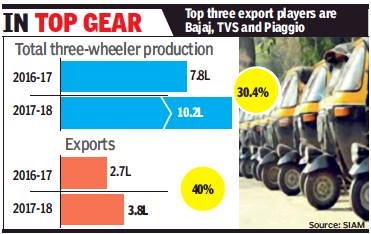
From: Nandini Sengupta, India Inc produces 1m 3-wheelers in FY18, May 1, 2018: The Times of India
Permit Removal In Maha, New Ones In Delhi Aid Sales
Export Growth Highest In Industry
The three-wheeler industry has been in top gear all through the recently concluded financial year. The segment hit a million units in production for the first time and also clocked the highest percentage of export growth across all automotive segments, including both twoand four-wheelers.
According to data released by industry body Society of Indian Automobile Manufactures (SIAM), total threewheeler production for the financial year 2017-18 hit 10,21,911(over1million) units, though this was dominated by passenger carriers. Yearon-year, total three-wheeler production rose 30% from 7,83,721 units in FY16-17, with passenger carriers up nearly 40%. In terms of the variants, passenger carriers commanded nearly 90% of total production at 8,99,023 units, with goods carriers accounting for 1,22,888 units.
The segment did well both at home and in exports. Total three-wheeler domestic sales were up more than 24% for the fiscal — passenger carriers grew nearly 29%, while goods carriers grew just under 8%. At 6,35,698 units, total domestic sales accounted for under 70% of production, with exports the rest. Analysts say part of the reason for the domestic sales is linked to permits in two big markets — Maharashtra and Delhi. Maharashtra has done away with permits, while the Delhi has issued new ones.
Passenger carriers also dominated three-wheeler exports, contributing more than 90% of the total 3,81,002 units. Three-wheeler exports jumped over 40% — the highest export growth rate clocked by any vehicle category in FY18. Of that, people carriers saw a growth rate of over 40% at 3,76,811 units, while goods carriers expanded nearly 45% to 4,191 units.
What’s more, the export momentum is expected to continue in 2019 as well. According to a report on automotive exports by India Ratings and Research (IndRa), “Higher demand for the last-mile connectivity in emerging markets of Africa and Southeast Asia, due to developing infrastructure and an expected rise in demand for public transport, is likely to fuel three-wheeler exports’ growth. India exports as much as 38% of threewheeler production, mainly to Africa and Asia, to meet their last-mile connectivity requirements.”
Bajaj Auto was the top exporter with 70% of India’s total three-wheeler exports at 2,66,215 units. TVS was in second position with 82,255 units and 22% of the export market, while Piaggio was in third with 24,470 units and 6% share of the export pie.
Types of vehicles sold
2016: 25% were SUVs
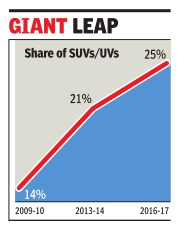
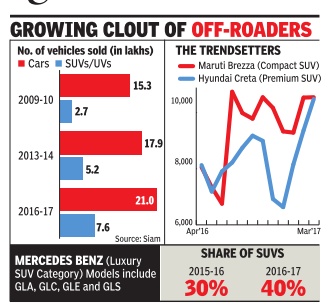
Pankaj Doval, 1 of every 4 vehicles sold is an SUV , April 12, 2017: The Times of India
The green lobby may see them as giant polluters, but SUVs have powered their way into the Indian passenger vehicles industry , accounting for one out of every four new vehicles sold in the market.
The data for vehicle sales, released by industry grouping Society of Indian Automobile Manufacturers, shows the growing clout of SUVs and utility vehicles when it comes to new purchases, a trend that seems to be getting stronger with each passing year.
Against a 14% share in the overall passenger vehicle sales at the end of March 2010, the same has crossed 25% at the end of March this year.And this is only going to get stronger in the coming years, if the trends and new model launches are any indication. The pace of growth in the demand for SUVs -where diesel is the preferred engine option -has been nothing short of spectacular. SUV sales shot up by 30% in 2016-17, a remarkable performance when compared to the 4% growth in sales of cars.
“SUVs are a global trend and very much liked in India as well. The large and varied spread of the country , with strong challenges when it comes to road infrastructure, makes them a necessity when one wants a stronger, safer and high-seating vehicle,“ said Rakesh Srivastava, senior VP (sales & marketing), at Hyundai India.
“This trend will continue and I feel that the share of SUVs will rise to nearly 30% over the next one year.“
The appetite for the off-roaders, which come with higher ground clearance and an extra punch of power to manipulate tougher terrains, has been seen across price points. So, while there has been a strong growth in the compact SUV segment (priced under Rs 10 lakh and having models such as Maruti Brezza and Ford Ecosport), an equally robust buyer pull has been there in the bigger segments for vehicles such as Hyundai's Creta, which is priced above Rs 10 lakh. Companies have recog nised the trend and are tailor-making products that smack of SUV cues.Nothing signified this more aptly than the Renault Kwid, a small car that sports an “SUV-like“ design. “It is known as the chhota (mini) Duster in the market,“ a leading industry official said, linking the Kwid's success to its bigger sibling, the Duster SUV . And while auto-purists may complain that all products selling in the market do not carry original SUV characteristics -brute raw power, giant proportions and 4X4 (all-wheel drive) capability -the general population does not share the sentiment.
So, cross-overs and miniSUVs (powered by smaller diesel engines and less than four metres in length) are in great demand. “They seem to fit the bill as they are easy on the pocket when it comes to affordability, and also give a sense of off-roaders in their shape and design. The trick works with buyers and we are happy to ride the wave,“ an official with a top company said, requesting anonymi ty. A slew of new launches are also planned for the category, and these include vehicles by companies across all segments, ranging from Hyundai and Renault in the mass segment to Toyota and Audi in the premium segment.
Vehicle density
Vehicles in Delhi/ 2006-18
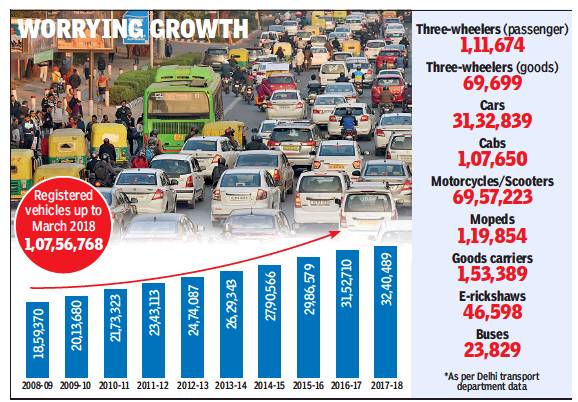
From: AmitAnand Choudhary, March 30, 2019: The Times of India
See graphic:
The number of all categories of Vehicles registered in Delhi/ 2006-18
Vehicle density in the states, 2014-15
The Times of India, December 20, 2016
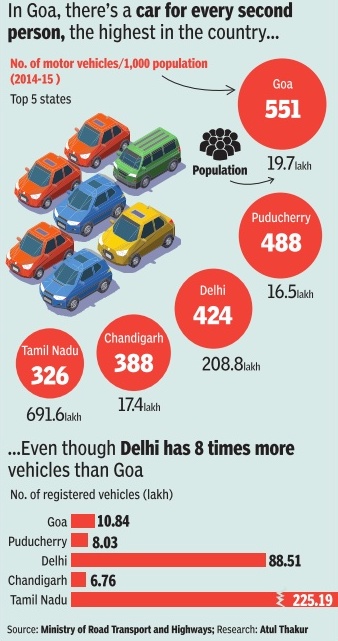
From: The Times of India, December 20, 2016
See graphic:
Number of motor vehicles per 1,000 population (2014-15);
Number of registered vehicles, state-wise
Delhi, with its 88.5 lakh registered vehicles, usually springs to mind first when one talks of vehicular population in states. But in terms of vehicle density or registered vehicles per 1,000 people, Delhi actually ranks third, behind Goa and Puducherry.
Number of vehicles, city-wise
January 28, 2015: The Times of India
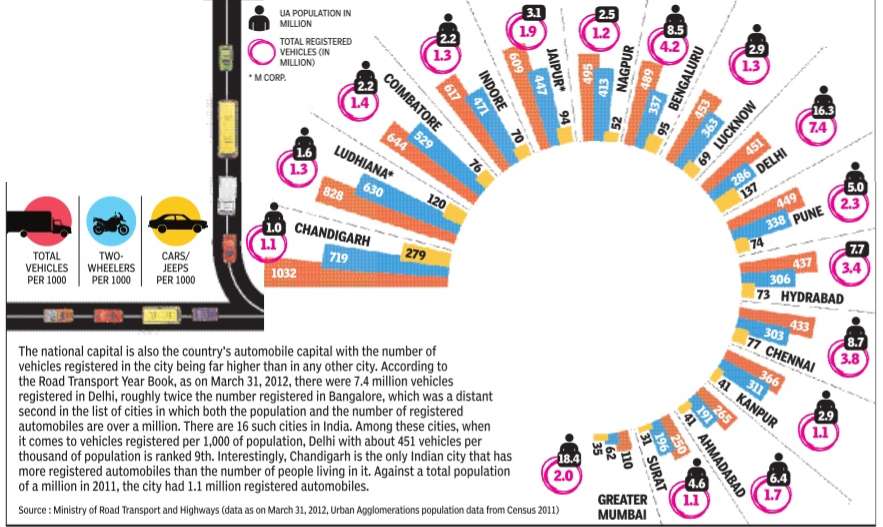
From: January 28, 2015: The Times of India
See graphic:
Cities with more than one million population and registered vehicles
The national capital is also the country's automobile capital with the number of vehicles registered in the city being far higher than in any other city. According to the Road Transport Year Book, as on March 31, 2012, there were 7.4 million vehicles registered in Delhi, roughly twice the number registered in Bangalore, which was a distant second in the list of cities in which both the population and the number of registered automobiles are over a million. There are 16 such cities in India. Among these cities, when it comes to vehicles registered per 1,000 of population, Delhi with about 451 vehicles per thousand of population is ranked 9th. Interestingly, Chandigarh is the only Indian city that has more registered automobiles than the number of people living in it. Against a total population of a million in 2011, the city had 1.1 million registered automobiles.
2015, Jan- Aug: Types of vehicles registered in Delhi
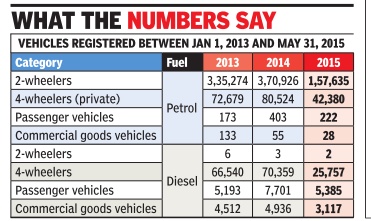
See graphic:
Types of vehicles registered in Delhi, Jan 2013- May 2015
Car density per km.; total numbers in metros/ 2015
The Times of India, Jun 20 2016
Somit Sen
At 430|km, Mumbai has highest car density
Mumbai's roads are bursting at the seams as 172 cars are added daily , while the length has remained close to 2,000km for few years.In six years there has been a 56% rise in private cars, which occupy 85% of road space and are an impediment for growth of public transport. There are 8.6 lakh private cars in the city at present.
Public vehicles have a population of 1.64 lakh and density of 82 vehicleskm of road. It is 19% of the total number private of cars plying on any stretch in the city .“Private cars will keep growing unless there are good alternatives and a robust public transport system of AC buses and metros,“ said expert Sunil Mone. “The Ghatkopar-Versova metro has dissuaded many from using cars along east-west corridor.“
Private cars have also become affordable for the middle class.Mumbai Transport Forum coconvener Rishi Aggarwal said, “It is easy to get a loan with comfortable EMIs of Rs 5,000-8,000 for a hatchback. Parking will become a nightmare if the car population goes unchecked.“
Ashok Datar of the Mumbai Environmental Social Network said, “Public transport can never grow unless we remove cars par ked on the road at least on major arteries. About 20% road space is used for car parking.“
Aggarwal said the government should also encourage aggregator AC buses, with each carrying 40-45 passengers, freeing up significant road space. “Another issue is noise and air pollution. For 25 years, the government has only been talking about green fuel, imposing restrictions on polluting vehicles and encouraging public transport. But the problem on the ground level remains unchanged,“ said activist Anil Galgali.
Experts said people aged 25-30 are more into buying cars as they are not guaranteed good public transport to travel to office. Last year, US transportation secretary Anthony Foxx stressed the need for an effective mass transit system and creation of more travel options for people commuting in the same space. Former transport commissioner V N More had proposed restricting private cars, and new registrations should be done only if there is an “assured parking space“ in the housing society . He had also proposed a hefty cess on petrol and diesel for cars and exorbitant parking charges in commercial areas.
Car density per km. in metros/ 2018
Somit Sen, Mumbai’s car density 5 times that of Delhi, March 25, 2019: The Times of India
The density of private cars in Mumbai soared by 18% in just two years, making it the most car-congested city in the country. The city has 510 cars for every km of road, almost five times higher than the corresponding number in Delhi, 108.
Pune is the next most-dense city with 359 cars per km, ahead of 319 per km in Kolkata, 297 in Chennai and 149 in Bangalore, show statistics from the respective state transport departments.
Mumbai’s high car density is mainly because of lack of road space. While Mumbai’s private car population is less than a third of Delhi’s, the city has just 2,000km of roads as compared with 28,000km in the national capital.
Burgeoning vehicle population and low road space in Mumbai contributes to enormous traffic jams, pollution and unauthorised parking on roads, as per statistics from Maharashtra transport department.
“Mumbai has been bursting at the seams past few years, and if there is no control over the purchase or mobility of private cars across the city, commuting by road will be a nightmare,” warned transport expert Ashok Datar, who has been advocating the use of buses for transportation in suburbs and island city.
In mid-2016, car density in Mumbai was 430 cars per km, which has now gone up to 510, according to Maharashtra transport ministry data. This has taken the total number of registered private cars to 10.2 lakh on city roads, roughly 28% of the total vehicular population in the city, which stands at 36 lakh, officials said.
A recent study by Mumbai Environmental Social Network, a think tank, showed that among private vehicles, 49% of road space is occupied by private cars of all types, including SUVs. This is one of the key reasons for increasing traffic congestion, with average speed on the Western Express highway dropping to 10kmph during peak hours, and on LBS Marg to less than 8kmph.
RTO officials said the maximum car registrations were in the western suburbs which has over 5 lakh registered cars, followed by 3.3 lakh in island city and 1.7 lakh private cars in the eastern suburbs of Mumbai.
Officials said that upmarket areas in eastern suburbs like Powai had maximum registrations for high-end cars and SUVs past few years. Chembur was the next big suburb in the eastern side to have car registrations in almost every middle class household, the officials stated. The Eastern Freeway is a preferred route for those in Chembur as it provides a high-speed connect to SoBo and saves time by over half an hour.
RTO records further show that Colaba-Cuffe Parade had a huge vehicular population, including several commercial vehicles, as compared to the tony areas of Malabar Hill or Nepean Sea Road-Peddar Road. In the western suburbs, Andheri and Goregaon had several residential and commercial hubs where car population had swelled over the years. The next three car-congested western suburbs were Kandivli, Bandra and Borivli with a large number of households going for bigger cars that occupy more road space, an official stated.
Transport experts are alarmed by the rise in private cars, which they feel are an “impediment” for the growth of public transport in the city. They also fear that the rise in vehicles could lead to parking woes. “There is an urgent need to set up a parking authority to implement the new parking policy, and also impose congestion tax in the business hubs,” said A V Shenoy of Mumbai Transport Forum. “The arterial road should be kept free of any parking (on both sides of the road) during peak hours. It will free up road space and allow movement of 50% more vehicles, especially buses,” he said.
Transport commissioners, in the past, have been suggesting ways to control the growth of car population in Mumbai and dissuade citizens from driving in their personal vehicles. An official said the government was now focussed on setting up several Metro rail corridors which will ensure a smooth commute in near future and encourage mass public transport.
